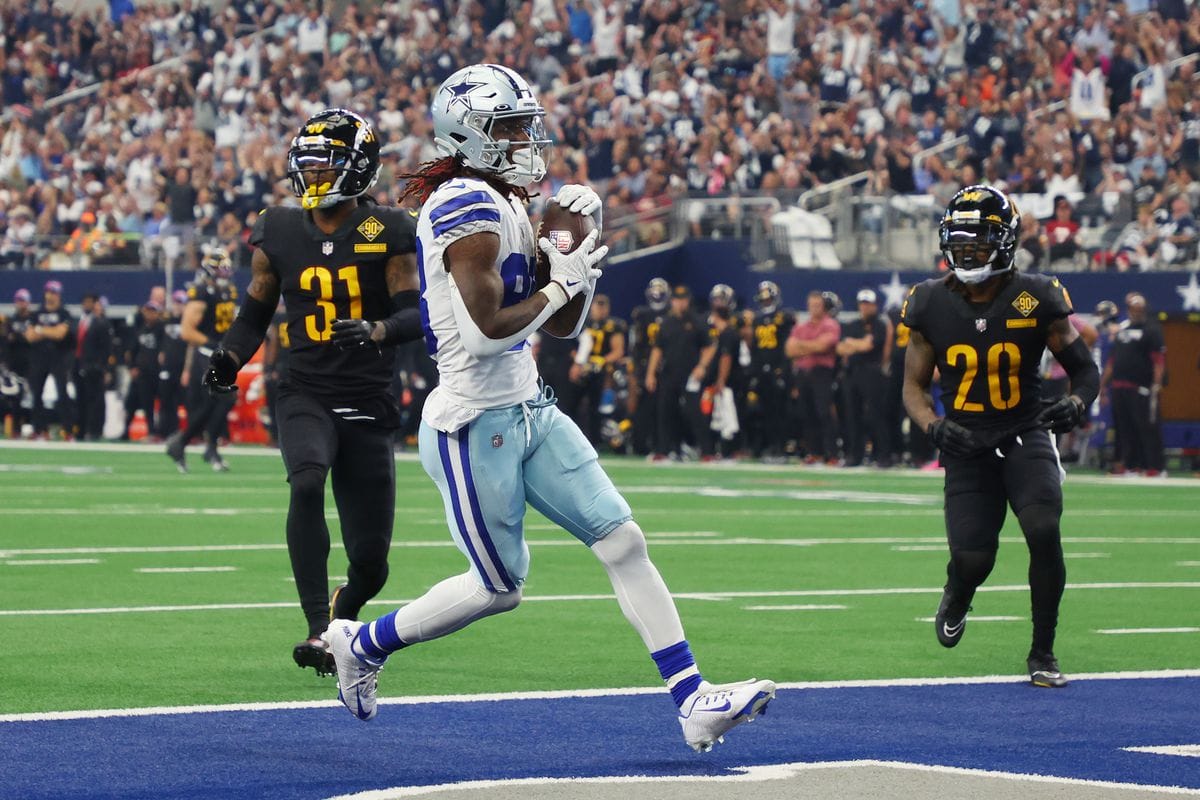
Thanksgiving Walkthrough: CeeDee Lamb, Centerpiece
Welcome to the Thanksgiving Walkthrough. In this article, I'll outline critical fantasy football context for this glorious Thanksgiving and Black Friday slate of Football.
In celebration of the holiday, I’ve decided to make this article completely free.
Happy Thanksgiving!
I’ll publish the Week 12 Walkthrough on Friday (a day later than usual) with the usual free preview/paywall setup.
All rankings and stats are updated through Week 11 except ESPN's open score and receiver ratings. As of publishing, these metrics hadn't been updated with Week 11 data.
(The stats below are from PFF, NFLfastR, rbsdm.com, RotoViz, FantasyLabs, ESPN, NFL Next Gen, and Fantasy Life).
Quick Links
- Packers at Lions, 12:30 PM, Thanksgiving
- Commanders at Cowboys, 4:30 PM, Thanksgiving
- 49ers at Seahawks, 8:20 PM, Thanksgiving
- Dolphins at Jets, 3 PM, Black Friday
Packers at Lions, 12:30 PM, Thanksgiving
Packers Implied Team Total: 20
Jordan Love is coming off one of his better games of the season. Against the Chargers, he delivered 9.5 EPA with a 49% success rate. Love was also uncharacteristically accurate, with a completion percentage 3.7% over expected.
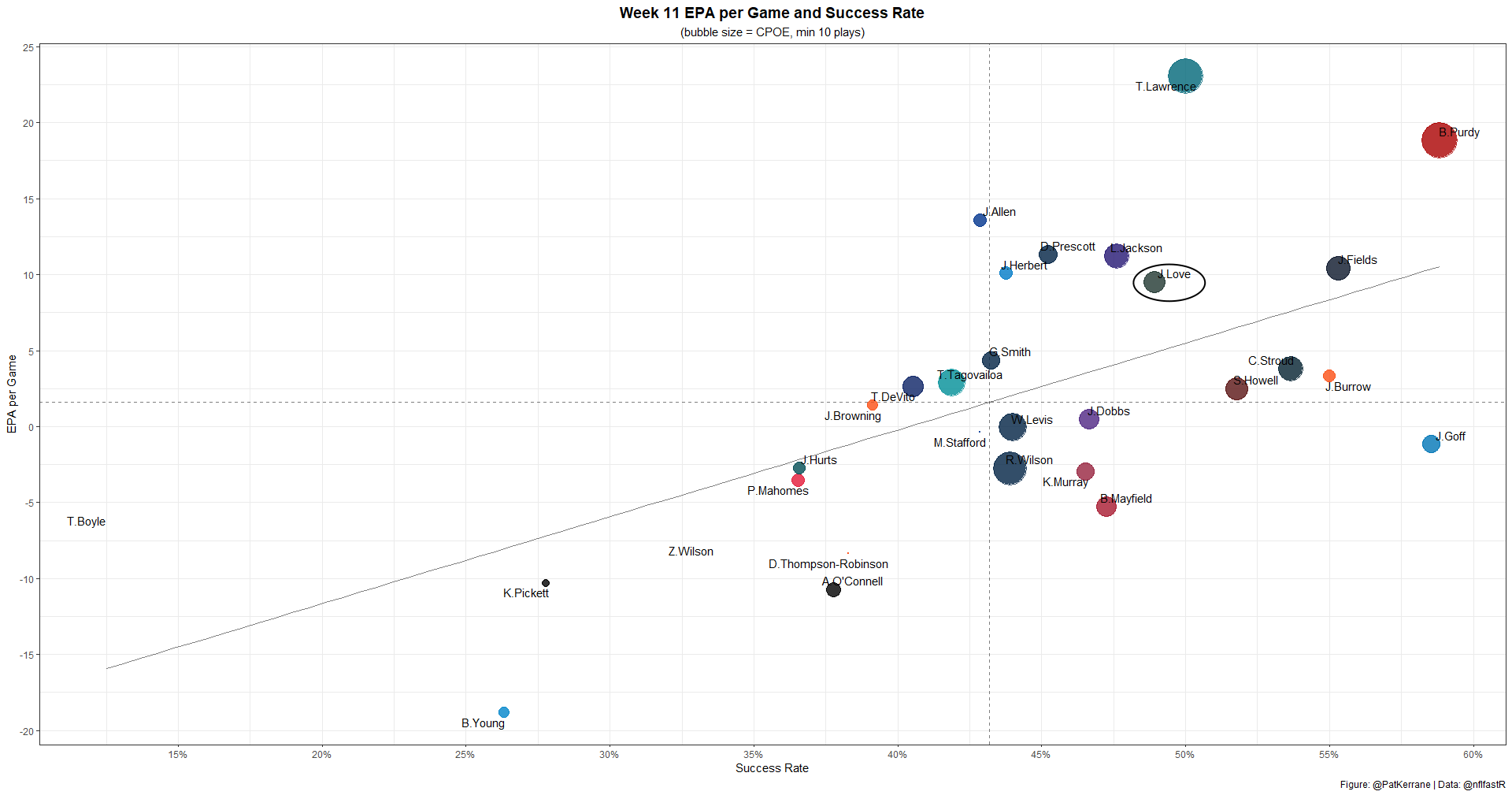
Love hit nine 15+ yard pass plays last week, second only to C.J. Stroud. At his best, Love can facilitate big plays. However, he’s far less accurate than Stroud… and most other QBs. This leads to inconsistent play.
Although Love has been decently efficient this year – ranking QB13 in EPA per game – he’s struggled with accuracy and consistency, ranking QB32 in CPOE and QB24 in success rate.
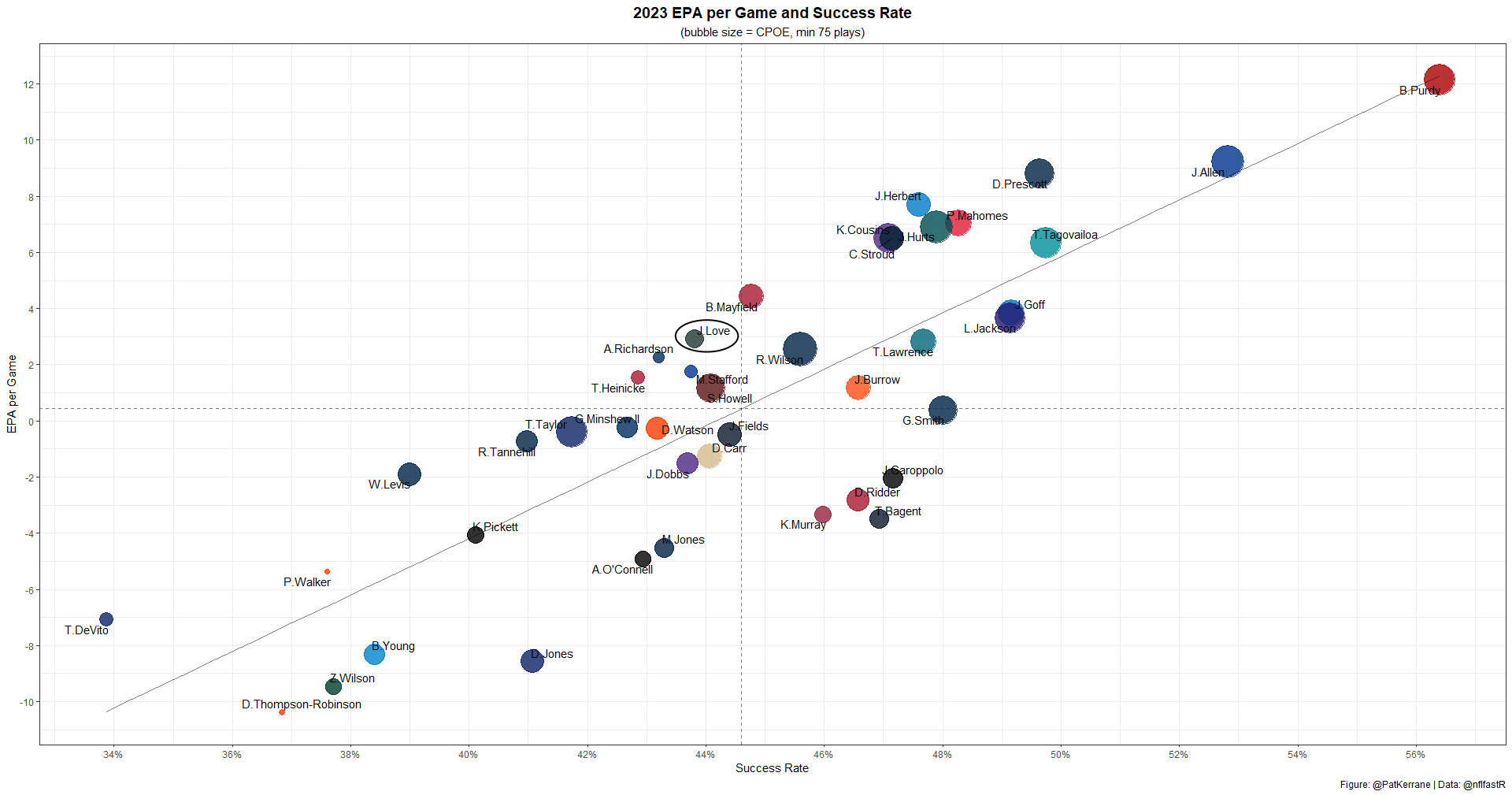
Fortunately, Love gets a matchup against a Lions defense that is allowing explosive passes at a high rate. Even if Love botches a few long attempts, he’ll get enough opportunities to make this matchup interesting.
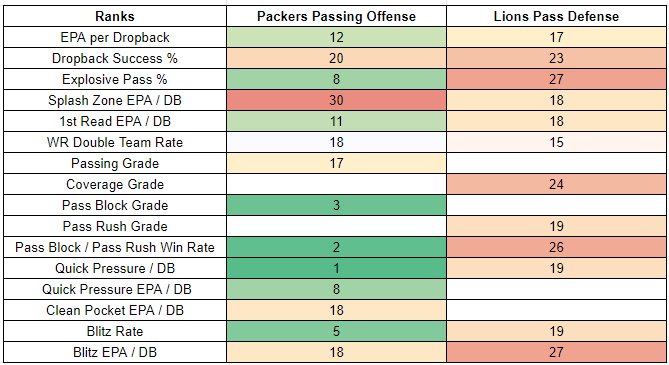
Generally, the Packers aren’t very aggressive. With a -1% PROE they’re a balanced team. They’ve had a similar pass/run approach to the Jets and Panthers.
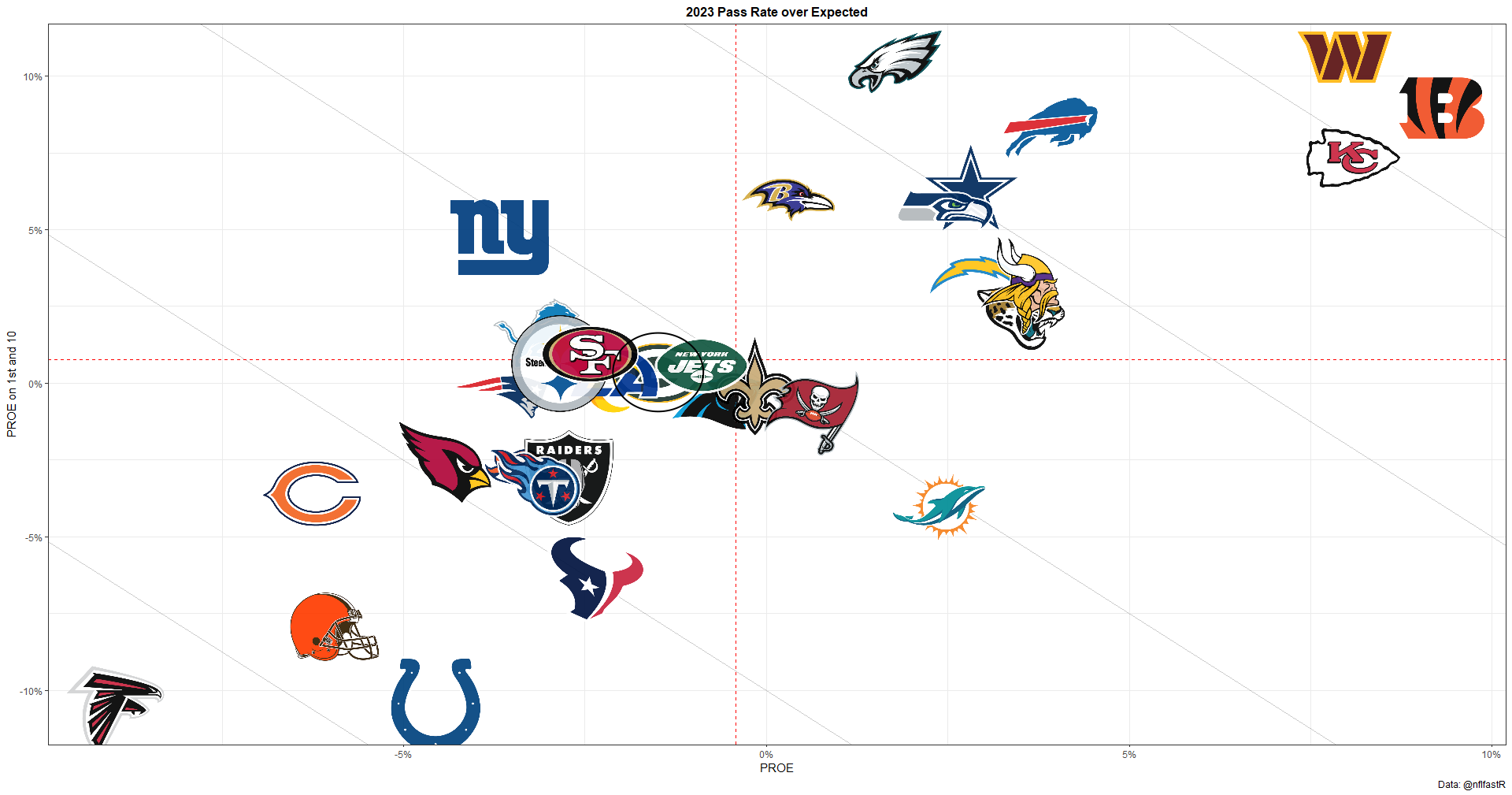
Against the Chargers, the Packers showed a bit more life, though. They posted a 2% PROE with a 5% PROE on 1st-and-10. I’d begun viewing the Packers as a conservative team, but they showed last week that they’re still willing to play aggressively in the right game environment.
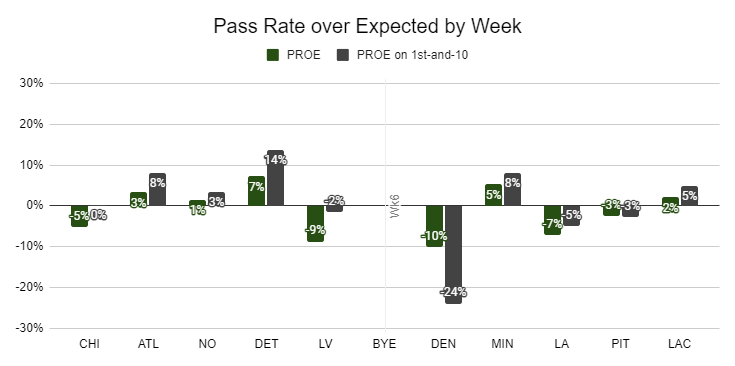
And this looks like a promising game environment for another pass-first game plan. The Lions have an ineffective pass rush and are susceptible to big plays. Like last week, Love should have time to throw.
And if the Packers increase their passing volume here, they’ll simply be following the established game plan against the Lions. Teams have averaged a 3% PROE against the Lions with a 3% shift to the pass.

Even with the potential for increased passing volume and strong QB play, Christian Watson will be tough to trust.
The Packers have seven players with 100+ routes run, and only A.J. Dillon (0.84) has a lower YPRR than Watson (1.21).
Watson’s inefficiency is striking… but I’m also being a bit unfair with this framing. Watson is playing a boom/bust role for an inaccurate and inconsistent QB. His YPRR could be quite a bit higher. With a league-average yards per target for his depth of target, Watson would have a much stronger 1.85 YPRR. Only Romeo Doubs (1.87) ranks higher for Green Bay.
Still, Watson's inability to graduate from this specialized role is unnerving. At this point, it’s hard to make a compelling case that he’s the Packers’ No. 1 WR. He trails Romeo Doubs in target share, first-read target rate and YPRR.
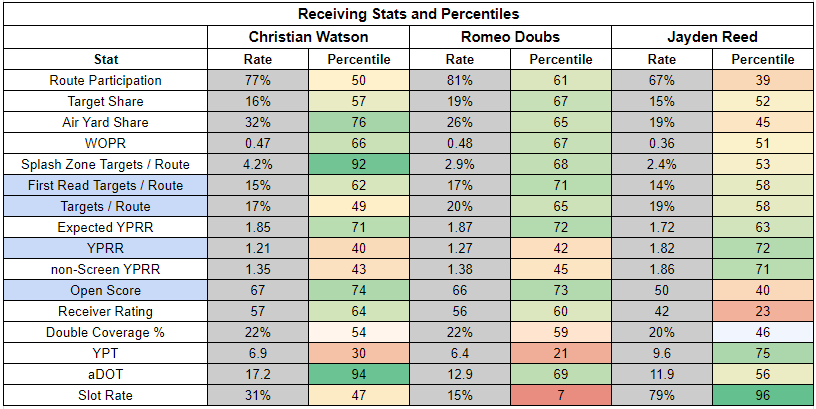
And yet… Watson's skillset is a great fit for this matchup. With an absurd 17.2 aDOT, he’s never going to be reliable week-to-week. But he’s also consistently live for big plays. Watson’s route participation has been lower than ideal, but that’s been the case all season. Even with Dontayvion Wicks starting to get more run, Watson’s playing time has been consistent. With Wicks unlikely to play this week, Watson's routes are likely to increase, if anything. Regardless, he’ll be out there running a lot of deep routes. And this is a good spot for Love to connect with him.

Jayden Reed’s playing time has been far less consistent than Watson’s. With the Packers implementing a pass-first game plan against the Chargers, Reed saw his playing time spike. After two weeks of sub-60% route participation, he spiked to 79%. Since Week 5, Reed has only hit 60%+ route participation twice… but hit marks of 88% and 79% in those two outings.
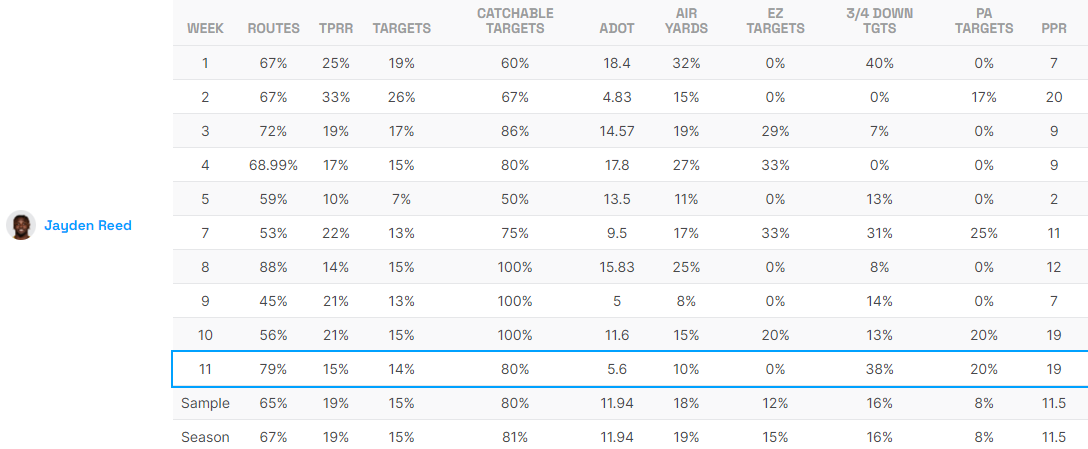
Reed’s inconsistent playing time is frustrating because, unlike Watson and Doubs, he’s been able to convert theoretical yards into real-life statistically recognized yards. His playing time uncertainty gives him a lower floor than he deserves, but this matchup sets him up for another solid mark in route participation. He's a viable FLEX.
Luke Musgrave is dealing with an abdomen injury, making his status a bit uncertain. But he’s a functional bet on increased pass volume.
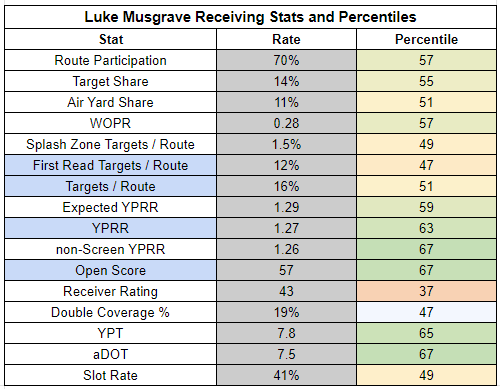
Even if the Packers trail throughout this game while primarily attacking the Lions’ vulnerable pass defense, they’re unlikely to get completely carried away with the passing game. Matt LaFleur has generally tried to manage Love, and he would likely prefer to keep that overarching approach in place against a middling Lions run defense.

Even if Aaron Jones (knee) misses the game, the Packers run game might not take a major hit. Unfortunately, Jones has not been a good rusher this year.
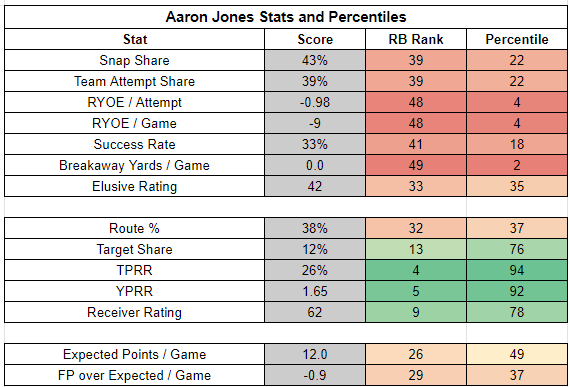
Jones remains an elite receiving weapon, but A.J. Dillon has been the better runner. That’s a tough pill to swallow, given how uninspiring Dillon has been, but that’s where we’re at.
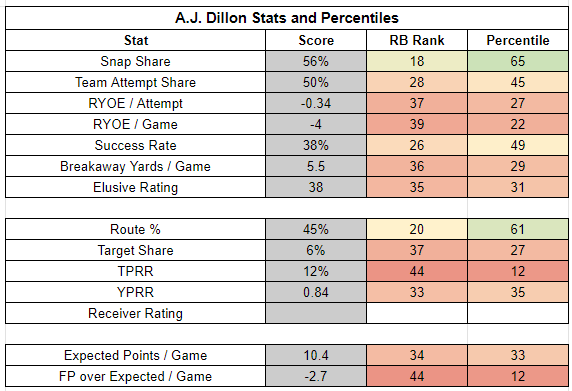
If Jones misses this game, we would normally expect to see Dillon handle a big snap share. But he is dealing with a groin injury, putting his status in question. The Wednesday injury report will be crucial for both backs.
Lions Implied Team Total: 27.5
Jared Goff tossed three interceptions against the Bears, which led to negative EPA per play for the second time this season. But unlike his meltdown against the Ravens, Goff was highly consistent against the Bears, turning in an elite 59th-percentile success rate.
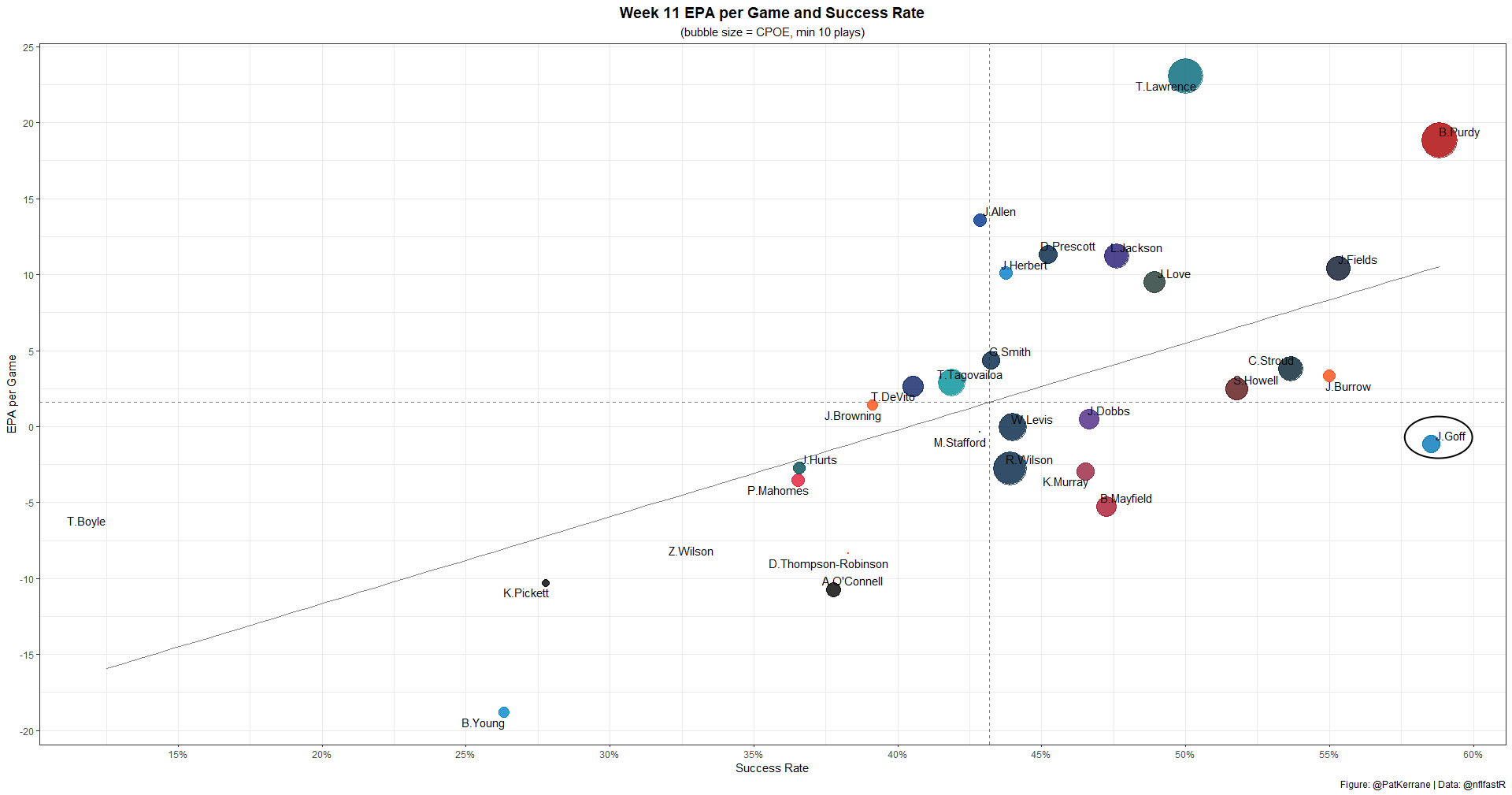
Goff has been highly consistent all season, ranking QB6 in success rate. He’s also been solidly efficient, ranking QB11 in EPA per game.
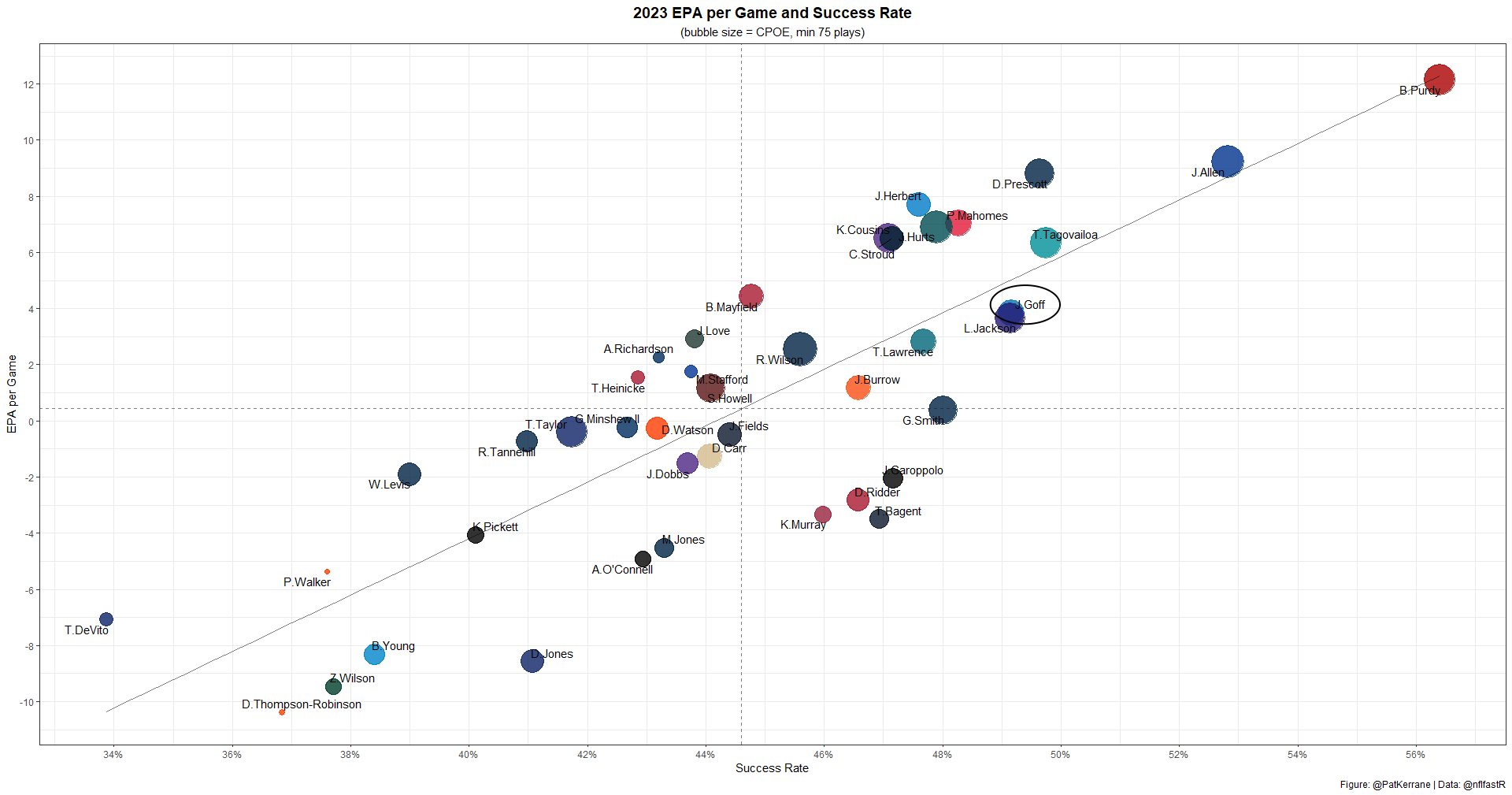
Goff faces a Packers defense that presents a somewhat difficult matchup. The Packers defend the middle of the field well, ranking seventh in splash zone coverage. Green Bay is similar to Baltimore in that sense; the Ravens rank ninth in splash zone coverage. And given Goff's meltdown against the Ravens, similar to Baltimore is not what we're looking for.
But unlike the Ravens, the Packers aren’t faring well against first-read throws. And they are a much less formidable defense overall.
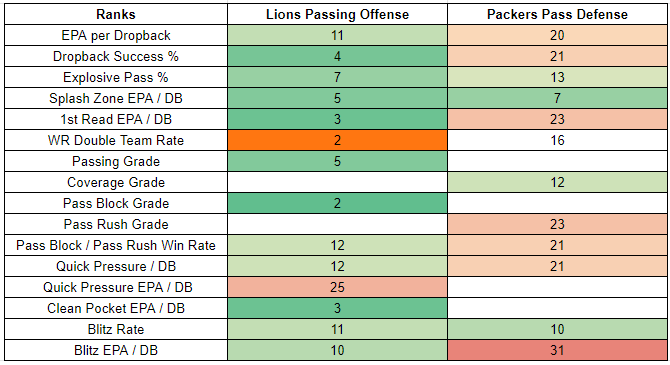
Goff is more fun when he can relentlessly attack the middle of the field. Goff’s two highest marks in EPA per play have come against the Buccaneers (Week 6) and Chargers (Week 10). Los Angeles and Tampa Bay rank 31st and 32nd in splash zone coverage.
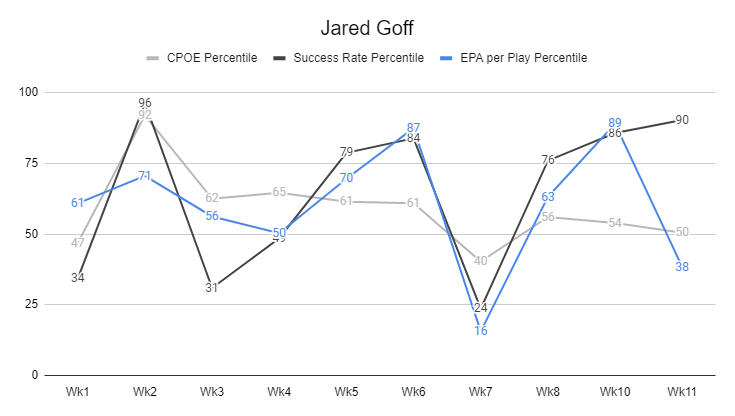
Goff was serviceable against the Packers in Week 4, but they’re built to at least partially limit his primary method of attack.
Like Goff, Amon-Ra St. Brown is most fun when the Lions can attack the deep middle of the field. He put up 67 yards after catch against the Buccaneers and 70 against the Chargers, his two highest totals of the season.
But even if not at peak efficiency, St. Brown should see plenty of targets against a defense that doesn’t double-team at a high rate. In Green Bay, St. Brown was double-teamed on just 6% of his routes; he’s averaging a 21% rate this season.
And with an elite 31% target share and 28% TPRR, St. Brown’s volume is secure. He’s a clear WR1.
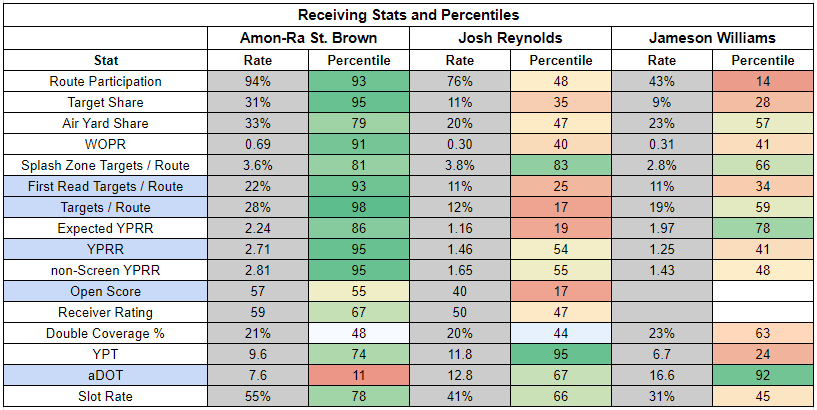
Jameson Williams is a far more speculative play. But Williams’ playing time against the Bears was highly encouraging. After setting a season-high 55% route participation against the Chargers, Williams made another leap forward, posting 66% route participation against Chicago.

Dwain McFarland sums up the situation succinctly:
"Williams registered a season-high 66% route participation and has a solid three-week trend (34%, 55%, 66%). He came through with 12.4 fantasy points on two receptions for 44 yards and a score on three targets. Williams UPGRADES to WR5 territory and offers big-play upside."
Williams’ 16.6 aDOT is extremely deep. The Packers have been decent at limiting plays this season but far from elite. By forcing Jared Goff to pivot from his usual over-the-middle throws, it’s possible they open themselves up to additional deep shots. Williams is the live-a-little play of the week.
Sam LaPorta has been a bit quiet since his 8/57/1 spike week against the Raiders, but he’s seen five targets in each of the last two games and hasn’t seen fewer than four targets in any game all season. Only Travis Kelce, Trey McBride, and T.J. Hockenson have a higher TPRR among tight ends.
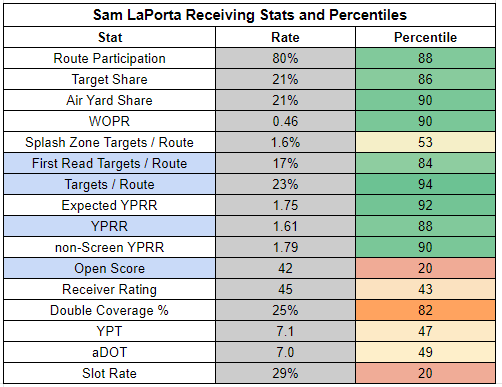
The Lions' passing game should be productive, but overall passing volume could be somewhat limited.
Detroit just faced a Chicago defense that is strong against the run and weak against the pass, but the Lions still operated with a clear tilt to the run.
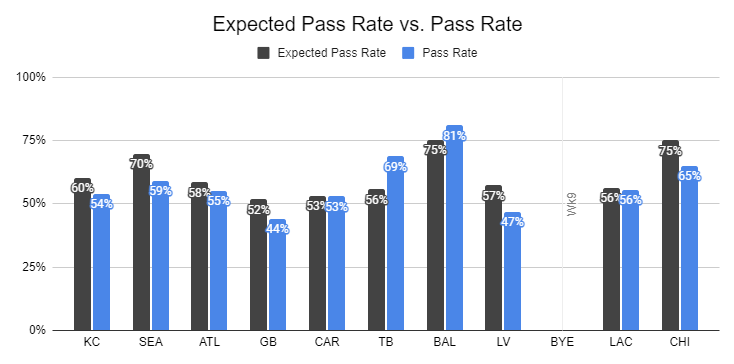
This week, Dan Campbell gets a run-funnel Packers defense.

Dan Campbell isn’t going to misdiagnose this matchup. The Packers are a run funnel because they aren’t very good against the run. The Lions should feel comfortable leaning into their primary mode of attack.

Last week demonstrated that a conservative Lions game plan is likely to go through David Montgomery. Against the Bears, Montgomery handled 57% of carries.

Montgomery has been a very impressive rusher this season. He ranks RB2 in success rate and is combining that with elite burst. He profiles as a TD-or-bust RB2 play even with Jahmyr Gibbs heavily involved.
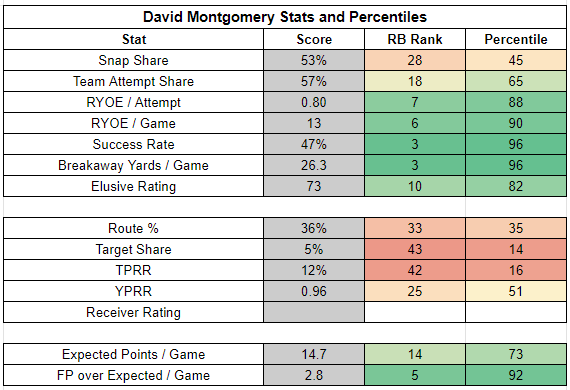
We should expect Gibbs to be heavily involved, though. He’s handled 58% of snaps in each of the last two games, with target shares of 16% and 19%.
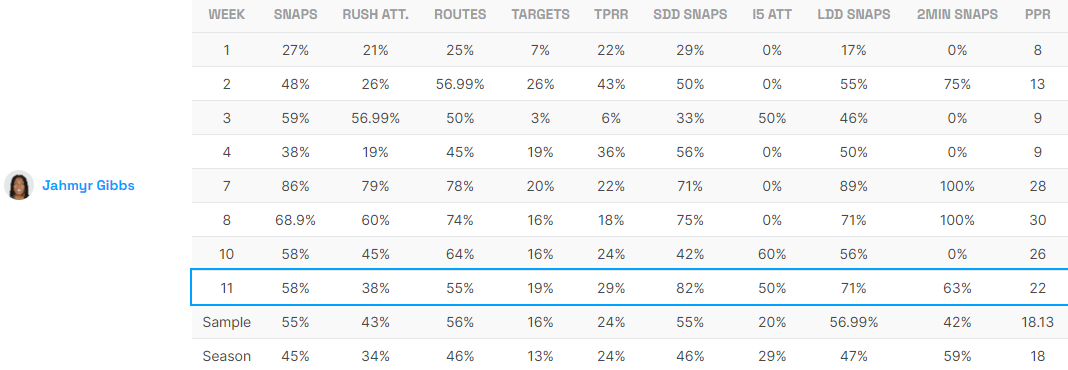
Last week, Gibbs and Montgomery both saw 14 opportunities but Gibbs’ six targets resulted in a workload worth 17.4 expected points. Montgomery’s two targets limited him to just 12.4 expected points. Gibbs’ high-end receiving role makes him an RB1 even in a split backfield.
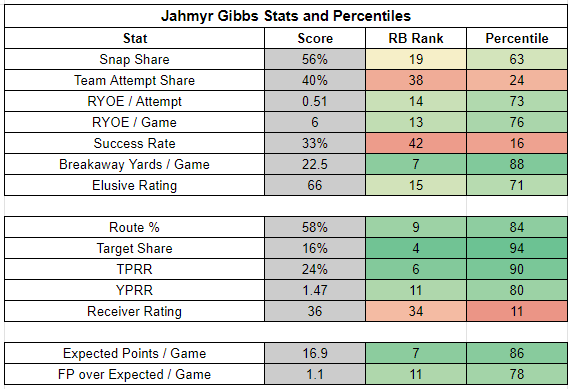
Commanders at Cowboys, 4:30 PM, Thanksgiving
Commanders Implied Team Total: 18.75
Sam Howell had a disappointing result against the Giants, taking four sacks and throwing three interceptions. But Howell's performance was also sneaky encouraging. With 35 yards and a TD, he had his most productive rushing performance of the year. Howell also posted a 66th-percentile success rate, his second-highest of the season.
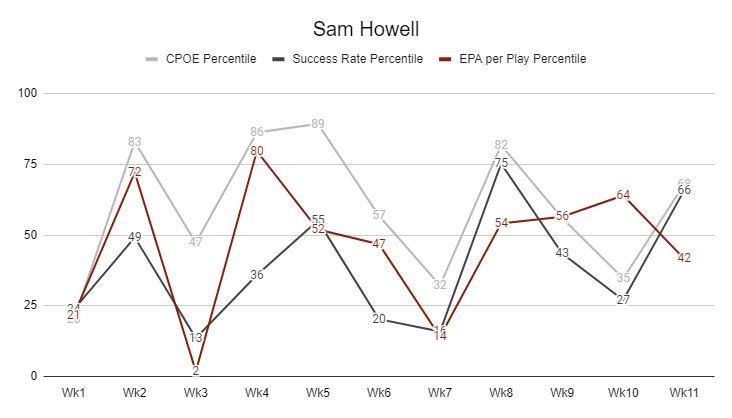
Howell has his issues but’s been solid overall, ranking QB19 in EPA per game and QB22 in success rate. His efficiency has been very similar to Matthew Stafford’s. And, like Stafford, he can make fun stuff happen in the right environment.
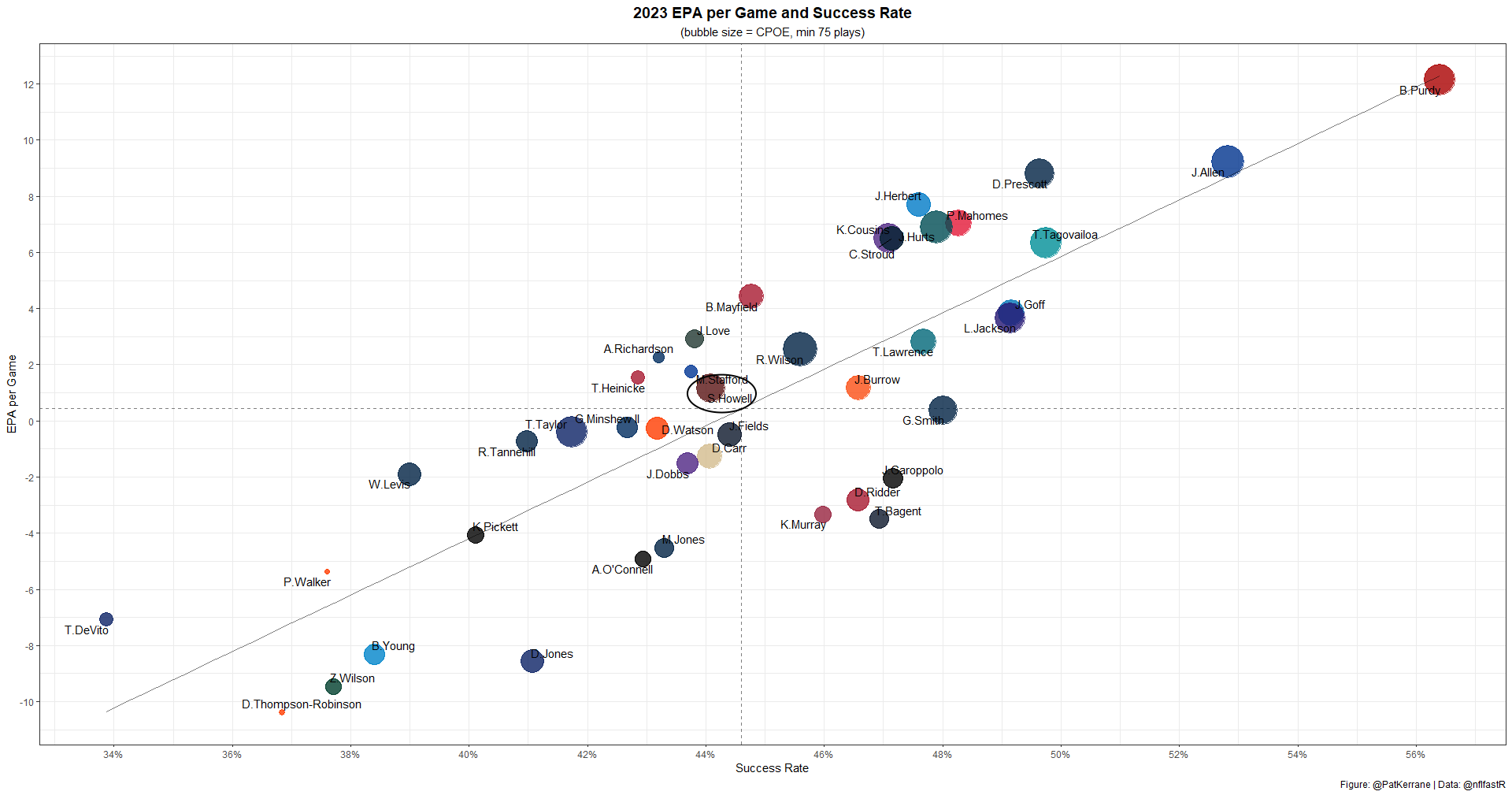
But this is a brutal environment. Howell is staring down a Cowboys defense that ranks first in pass rush win rate and quick pressure rate. For a QB who struggles with holding the ball, this is not the matchup you want to see.
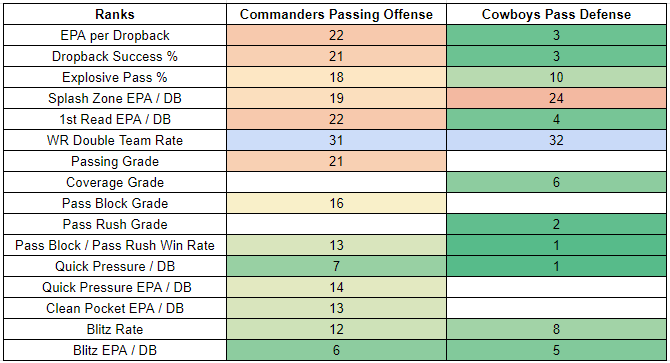
As I’ve previously outlined, Howell tends to stick with the primary design of the play longer than other QBs. This isn’t necessarily bad – Howell is willing to hang in the pocket and hunt for big plays – but it could look pretty bad this week. The Cowboys have been highly effective at limiting first-read efficiency and will be pressuring Howell quickly.
The Cowboys aren’t a perfect defense. But the Commanders don’t look well suited to take advantage of their vulnerabilities. The Cowboys double team at the lowest rate in the league and are vulnerable over the middle of the field. They could be exposed by Tyreek Hill in Week 16.
But this week, the Cowboys get a Commanders offense that doesn’t have a clear No. 1 option and isn’t attacking the deep middle all that effectively.
Sam Howell doesn’t have a problem attacking the middle of the field. He leads the NFL with 124 middle-of-the-field attempts. But 67% of those have traveled less than 10 air yards. The shallow middle of the field doesn't set up receivers for YAC the way the splash zone does. Howell ranks just QB20 in splash zone target rate.
And the Commanders’ target tree is so spread out that I think Eric Bieniemy might be doing a bit. After Curtis Samuel was ejected last week, Byron Pringle managed to tie Jahan Dotson with three receptions.
But in fairness to Bieniemy, this is likely related to talent rather than scheme. The Commanders’ WRs aren’t getting open. And the Cowboys' lack of double coverage isn’t likely to help much. No one is double-covering them as it is.
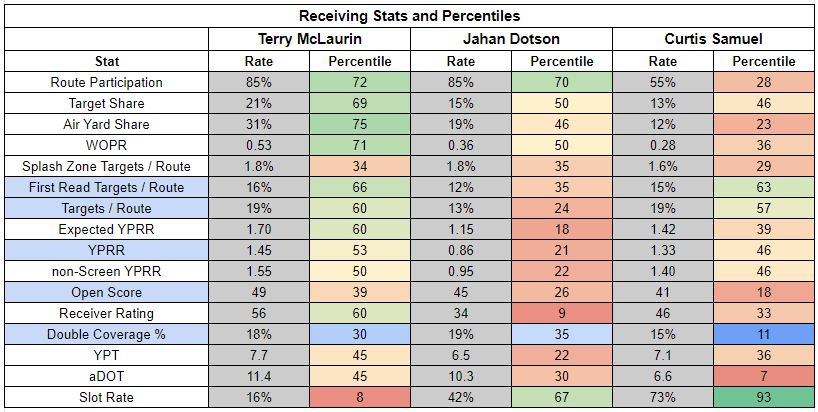
All three WRs are viable short-slate dart throws, but it’s very difficult to predict who will emerge as part of what will likely be a struggling passing game.
Logan Thomas is as good an option as any here. His 14% first-read target rate is strong for a tight end, and he’s being targeted shallowly, which should keep him involved if the Commanders emphasize the quick passing game.
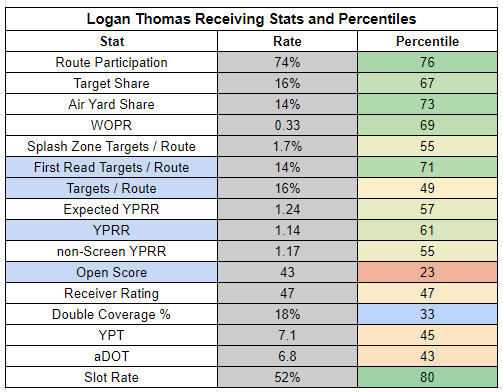
Passing efficiency is a risky bet… but passing volume is not.
For the first time all season, Washington posted a negative pass rate over expected in Week 11. But the Commanders still posted a 68% pass rate, which is 5% above the league average. Even when the Commanders play “conservatively,” they pass at a top-5 rate.
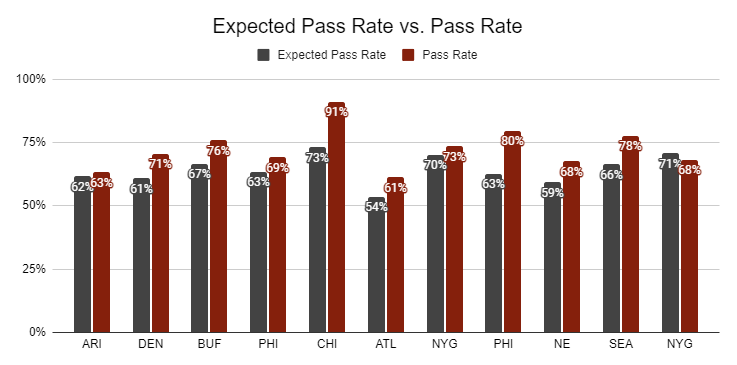
But the Cowboys can be run on. Only the Panthers have a lower rushing success rate, and they rank 26th in run stop win rate.

Typically, the issue with Brian Robinson is that he’s game script-dependent. But with Antonio Gibson out last week, Robinson dominated the backfield, posting a 78% snap share, 68% carry share, and 20% target share.
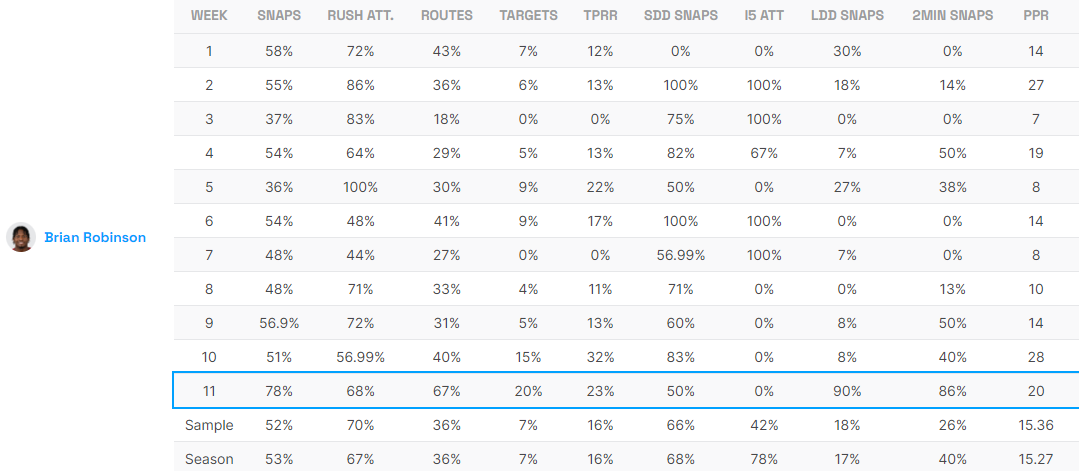
Robinson has impressed while picking up the receiving game slack. He ranks RB3 in YPRR and RB4 in receiver rating. It’s hard to have any confidence in Robinson’s receiving game role if Gibson returns, but it’s also hard to understand why Robinson doesn’t have total control of this backfield either way.
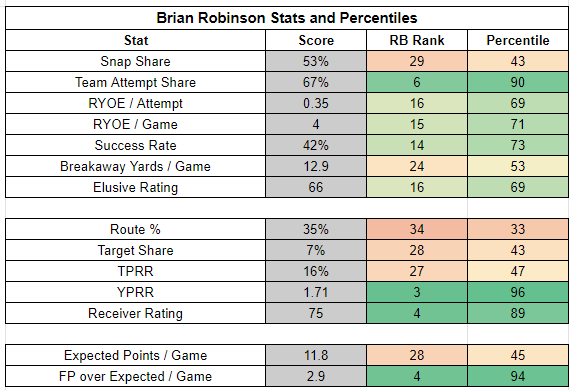
Cowboys Implied Team Total: 29.75
The Cowboys came out of their Week 7 bye with a new approach on offense, posting ultra-aggressive passing numbers in the three weeks that followed. But last week’s matchup against the Panthers was a test of how serious Mike McCarthy really is about this pass-heavy identity. McCarthy eased up a bit but still posted a 5% PROE against a run funnel Panthers defense. The Cowboys look committed to the pass.
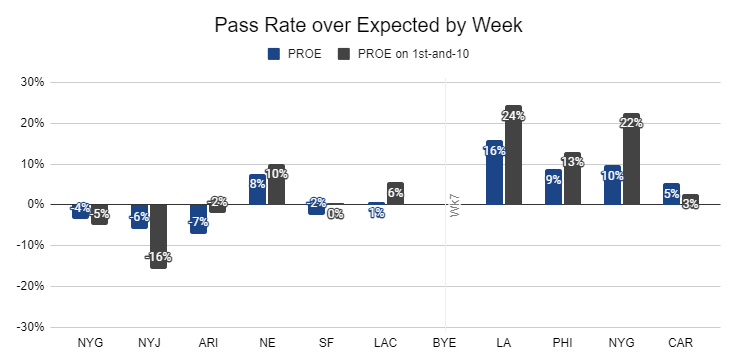
And Dallas now gets a Washington offense that is as committed to the pass as any team in the league and is profiling as a pass funnel defense after the Giants successfully went ultra pass-heavy against them with Tommy Devito under center.
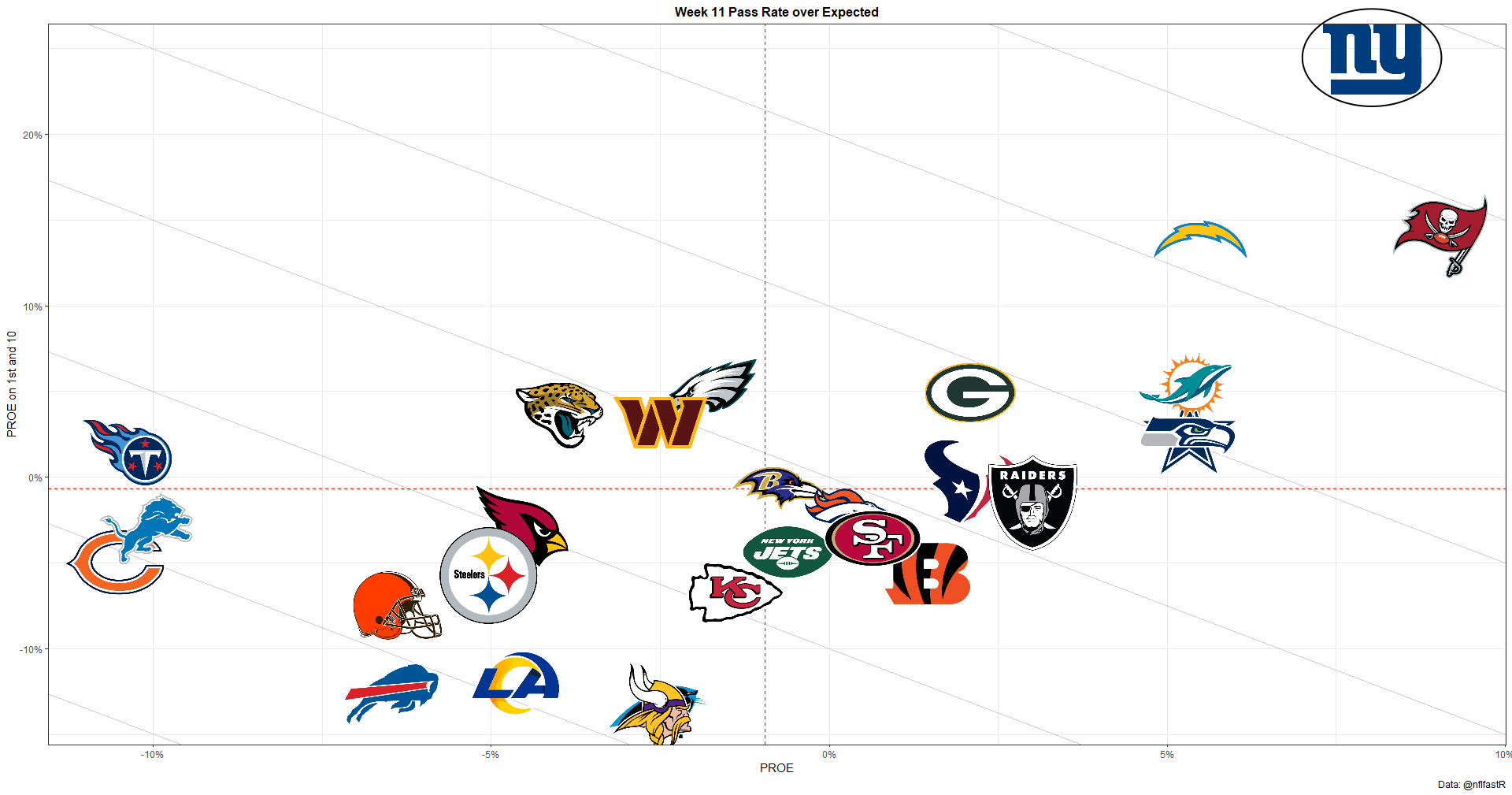
It’s not hard to see why the Giants were aggressive. The Commanders have been brutal against the pass, ranking 30th in EPA allowed per dropback and allowing explosive plays at the fourth-highest rate. The Commanders’ pass rush is also unintimidating.
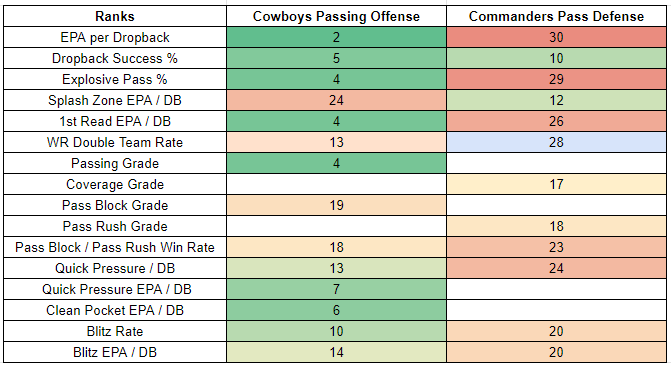
Best of all, the Commanders are not taking away the opposition’s first read. Dak Prescott and his weapons are doing something truly remarkable. Prescott leads the NFL with a first-read target on 69% of his dropbacks… but he also ranks QB3 in avoiding negative plays while still on the primary read of the play.
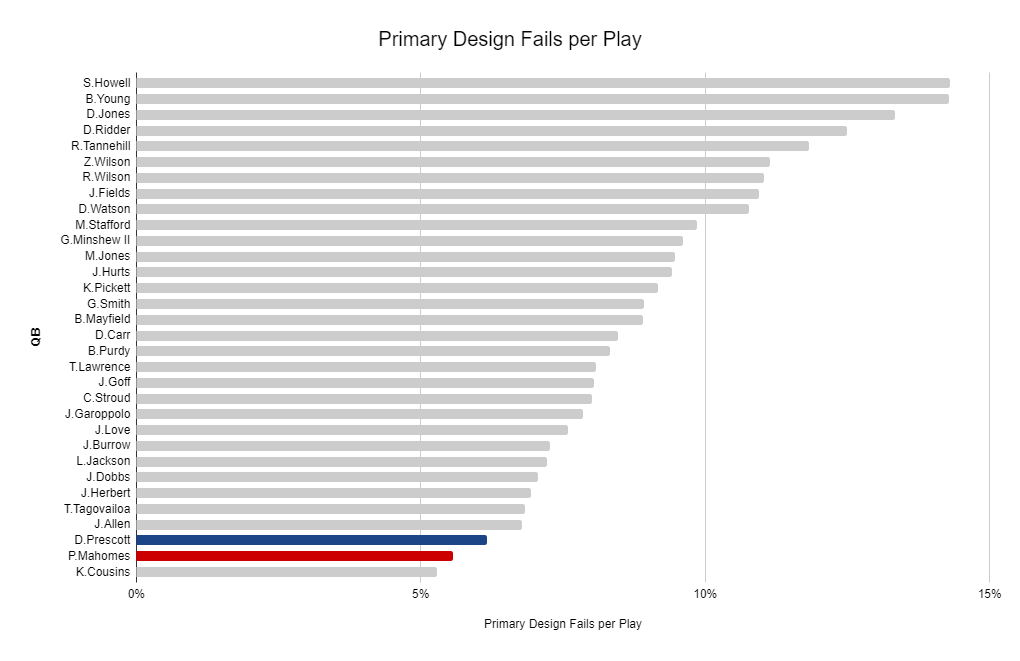
Patrick Mahomes is also doing an excellent job of avoiding negative plays on his first-read. He has the second-fewest interceptions, sacks, throwaways, and batted passes in the NFL while still on the primary design of the play. But Mahomes also ranks just QB39 in first-read attempt rate.
In other words, Mahomes is avoiding mistakes on his first read, but he’s also having to move off the primary design of the play a lot. We don’t need the numbers to tell us that Patrick Mahomes’ WRs are letting him down. Our eyes have us covered there. But the numbers see it too.
By contrast, Prescott is fully dialed in with his weapons. He’s sticking with the primary design of the play at a very high rate and is being rewarded with high-end efficiency. The Cowboys are producing the fifth-most efficiency on first-reads. And Prescott ranks QB3 in EPA per game.
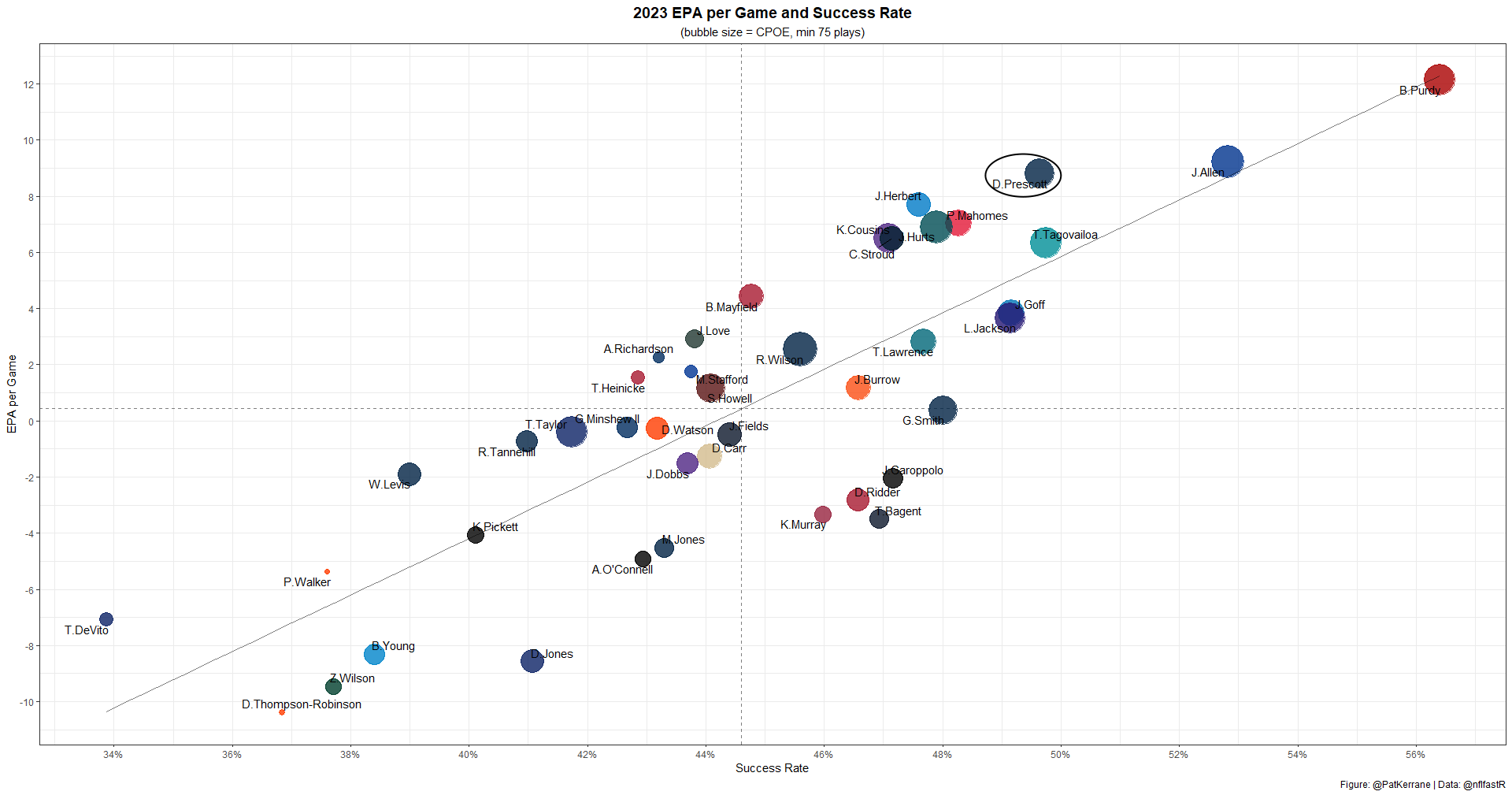
This goes hand in hand with CeeDee Lamb’s emergence as a truly elite fantasy WR. Lamb has an elite 23% first-read target rate. Only A.J. Brown, Tyreek Hill, Mike Evans, Cooper Kupp, and Justin Jefferson rank higher. When the Cowboys are able to execute in the passing game, Lamb is the centerpiece.
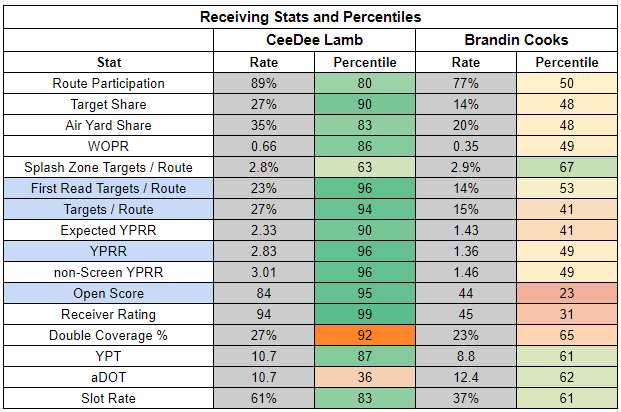
Brandin Cooks went nuts for a 9/179/1 receiving line in Week 10, so he clearly has upside as part of the Cowboys' aggressive new style. At the same time, his profile is far less enticing than Lamb’s. Week 10 was Cook’s only game with a 20%+ target share. Lamb has hit that mark six times. And Lamb's 24% target share against the Panthers was his lowest since the Cowboys' Week 7 bye. Cooks is a solid ceiling FLEX play, but he’s a far lower confidence piece than Lamb.
If simply betting on targets, Jake Ferguson looks like just as strong of an option as Cooks. The tight end leads 15% to 14% in target share, 16% to 14% in first-read target rate, and 18% to 15% in TPRR. Luke Schoonmaker poached a TD last week but ran just nine routes. Ferguson ran 35 routes, matching Brandin Cooks.
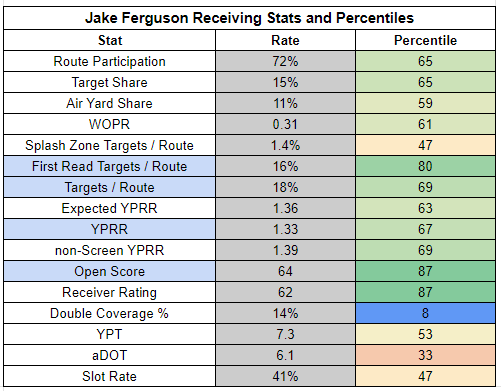
If looking to get a little off the board on the Thanksgiving slate, Jalen Tolbert needs to be on your radar.
Since Week 7, Michael Gallup has route participation marks of 51%, 49%, 50%, and 45%. His role appears directly impacted by Tolbert’s increased involvement.
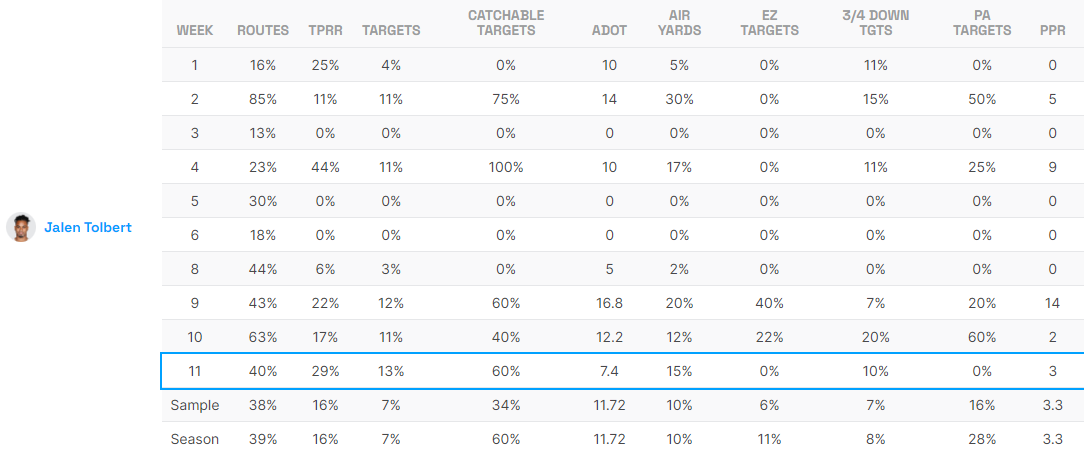
Tolbert hasn’t shown a ton this year. He has a very poor 0.85 YPRR and isn’t earning targets well with a 16% TPRR. But it’s hard to imagine he’s running routes any worse than Gallup, who ranks sixth percentile in open score.
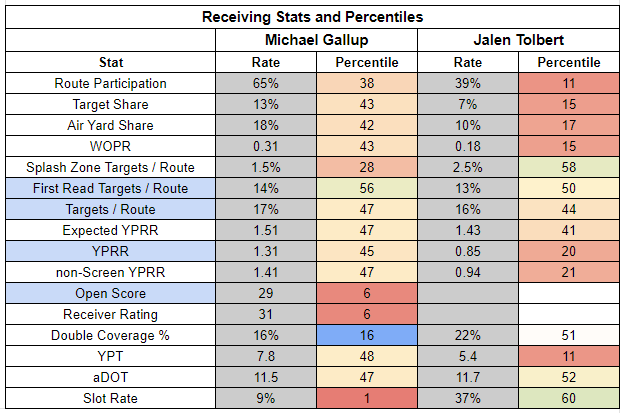
The Cowboys dialed back their passing game a bit last week, which made sense against a very poor Panthers run defense. If they were hoping to get Tony Pollard going in a good spot, the plan worked out well. Pollard posted a 67% success rate, the second-highest of the week. He also posted 18 yards over expected, the fifth-most of the week.
Pollard now gets a more difficult Commanders defense, on paper at least. The Commanders rank ninth in EPA allowed per rush, but in their last three games – since trading Montez Sweat and Chase Young – the Commanders rank 21st in EPA allowed per rush. And they just let up rush 48 yards over expected to Saquon Barkley.

Pollard’s efficiency profile remains very weak, but he’s a high-end RB2 as an 11-point home favorite against an exploitable run defense.
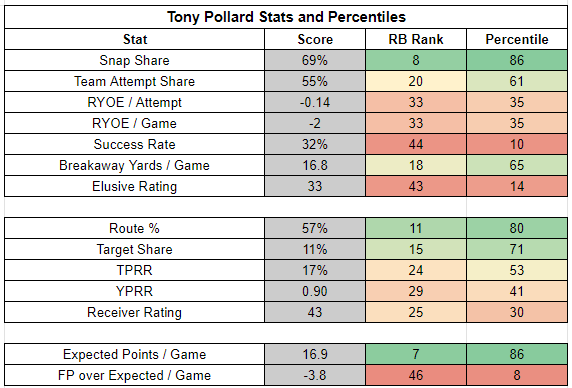
49ers at Seahawks, 8:20 PM, Thanksgiving
49ers Implied Team Total: 25
Last week set up as a near-perfect matchup for the 49ers’ offense. The only missing ingredient was an opposing offense that could push them. In their 27-14 win, the 49ers operated with a characteristic tilt to the run.
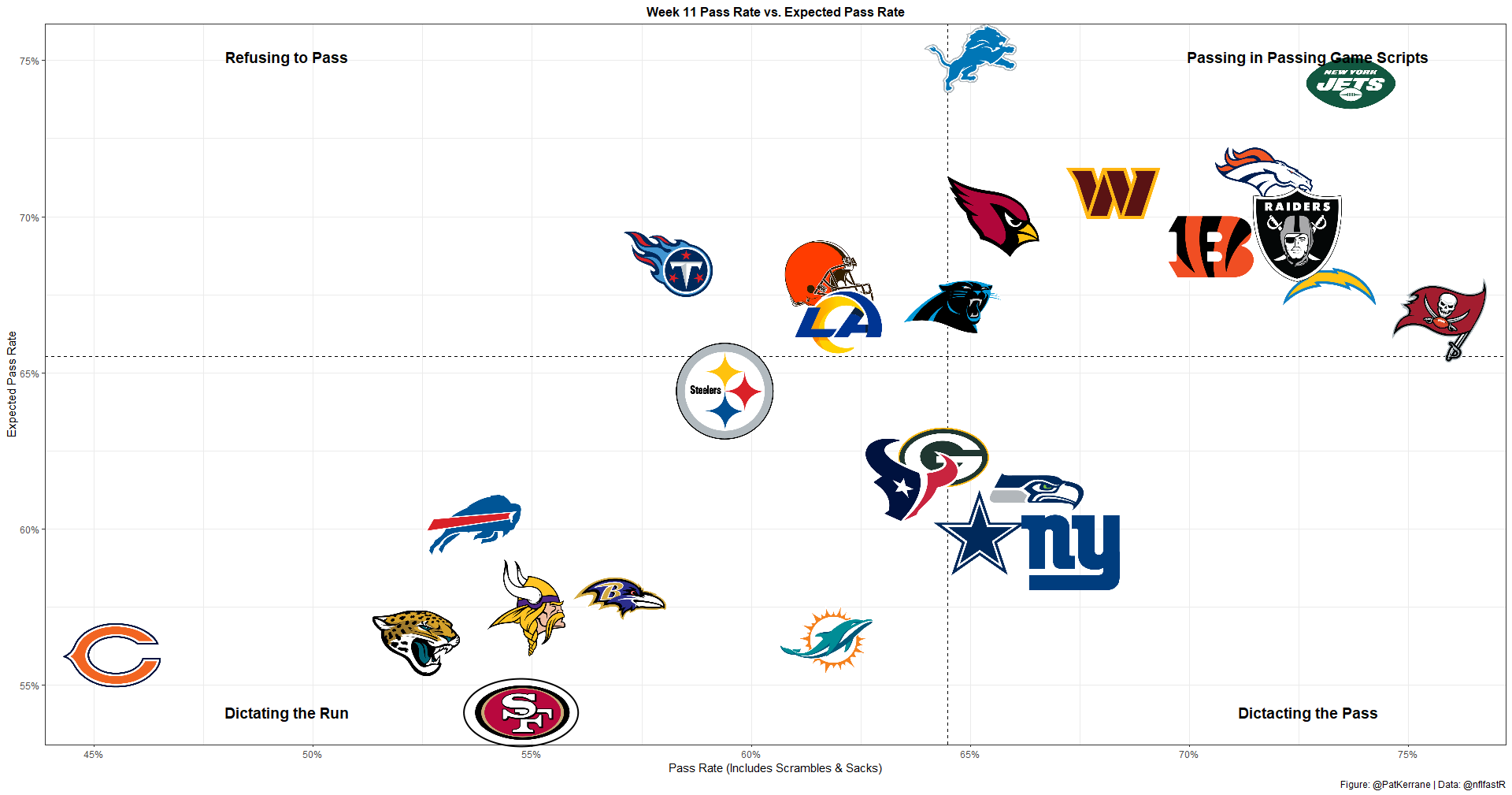
We’ve seen the 49ers post a pass rate above 55% just three times all season—in their only three losses of the year.
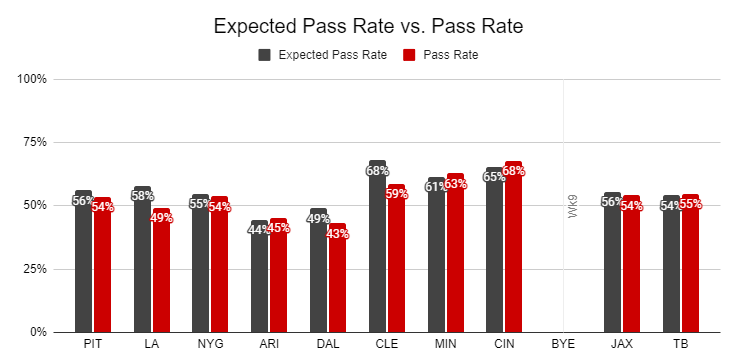
As last week showed, the 49ers are so gloriously efficient that they can turn in massive fantasy production even without a ton of volume. But volume is always something to keep in mind with San Francisco.
The 49ers now face a Seahawks defense that ranks 23rd in defending the splash zone. You can attack Seattle over the middle of the field, much like Tampa Bay. However, unlike the Buccaneers, the Seahawks are effectively limiting first-read production and have a dangerous pass rush.
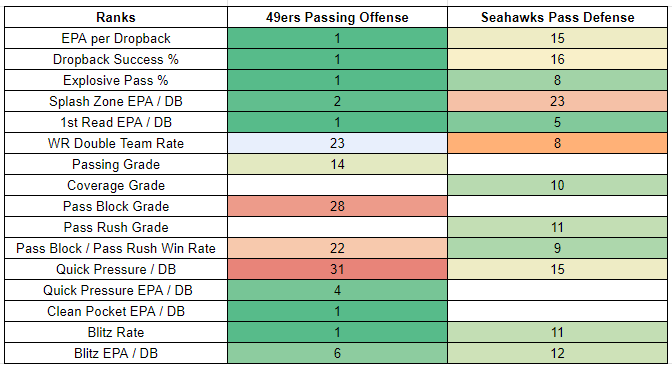
Purdy doesn’t melt under pressure. Teams are constantly blitzing him, and the 49ers are allowing quick pressure at the second-highest rate. But the 49ers rank sixth in EPA per blitzed dropback and fourth in EPA on dropbacks with quick pressure. Brock Purdy wouldn't be running away from the field in efficiency if he couldn't handle pressure.
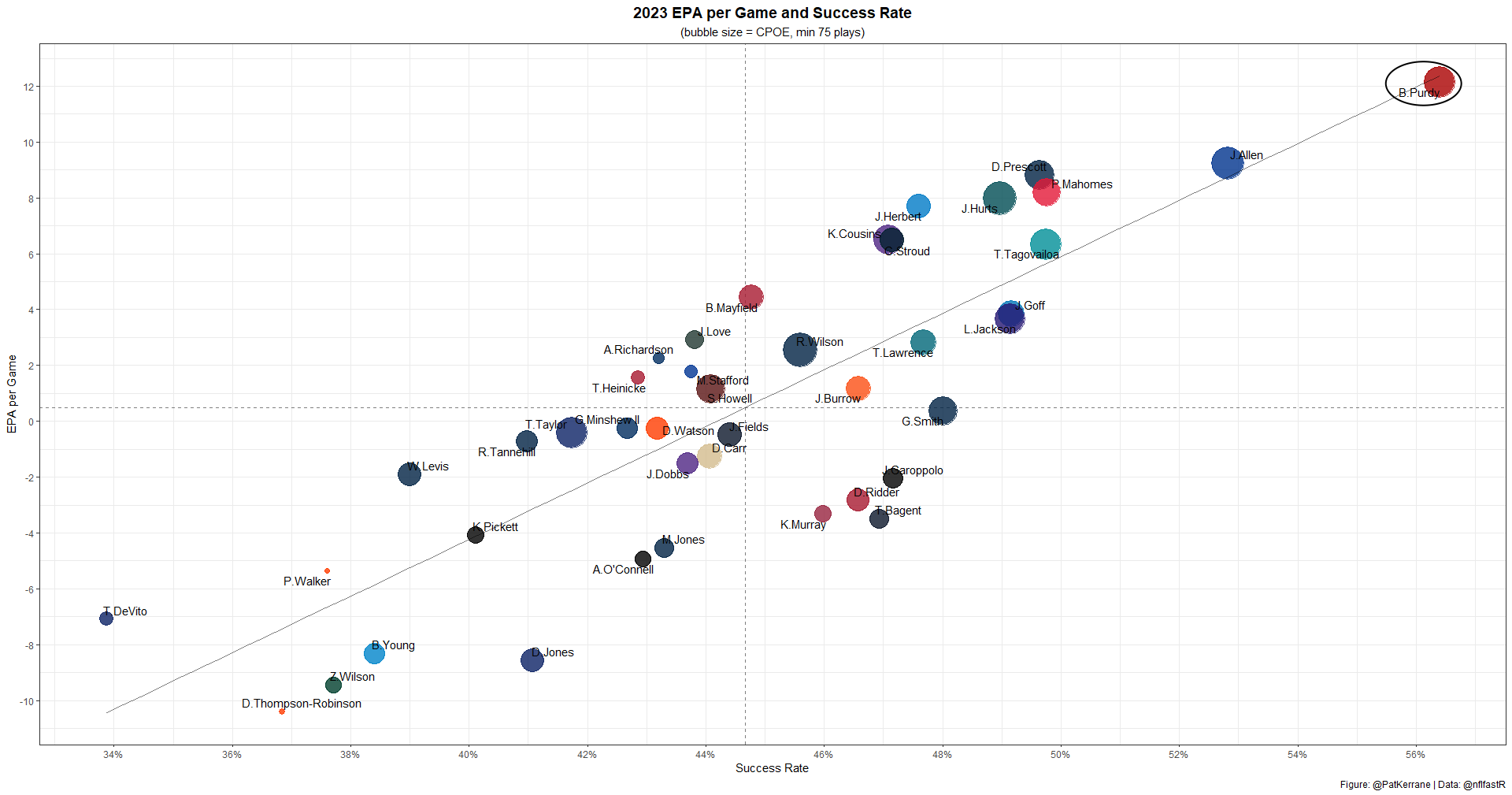
However, every QB is better from a clean pocket than when under pressure. Purdy has been remarkable at managing pressure, but the 49ers' pass-protection issues are still a major problem. And this is a problem we can expect the Seahawks to capitalize on effectively, to the point that we’ll likely see more of a quick passing game this week.
Yes… that’s Deebo Samuel’s music.
Brandon Aiyuk leads the 49ers with a 25% TPRR. Samuel is at 21%, with George Kittle at 20%. But on dropbacks with quick pressure, Samuel’s TPRR jumps to 22%, with Aiyuk falling to 19% and Kittle to 16%.
On throws of 2.0 seconds or less, we see an even more dramatic jump for Samuel. Samuel’s TPRR spikes to 35%, with Aiyuk at 24% and Kittle at 19%.
29% of Purdy's attempts have come within 2.0 seconds—these are not uncommon throws. Most notably, Brock Purdy attempted a season-high 18 throws within 2.0 seconds against the blitz-happy Giants in Week 3. Samuel went 6/129/1 on 12 targets. Critically, Brandon Aiyuk missed that game. But Samuel’s shallow route tree and screen ability make him a natural fit for the quick passing game, which we should see more of here than in recent weeks.
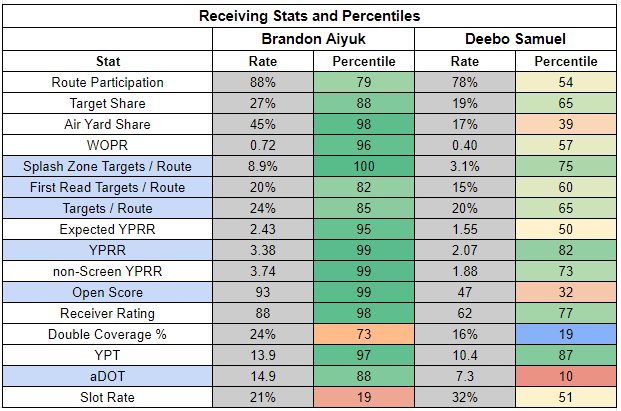
Although this matchup should boost Samuel’s involvement, Aiyuk remains a great play. He’s combining elite route running with elite target earning and he is doing all of this downfield, which we love to see.
George Kittle remains a strong play as well. He’s also combining route running, target earning, and downfield ability. If the 49ers can protect Purdy sufficiently, both Aiyuk and Kittle should be able to do damage against the Seahawks over the deep middle of the field.
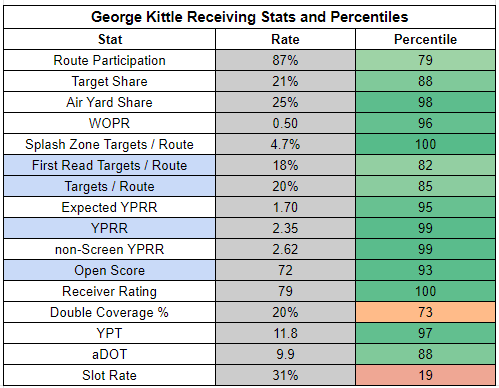
But, volume. Pesky volume. As 7-point favorites, the 49ers should be playing from ahead here. And although the Seahawks are a slight pass funnel, they’re not the type of defense that will alter Kyle Shanahan’s approach.

The Seahawks are solid against the run, but they’ll still have their hands full trying to stop a high-end 49ers running game.

Christian McCaffrey is an elite play. That's true every week. But this matchup is better than most. The 49ers should play from ahead, but they’ll also be contending with a solid Seahawks pass rush. That dynamic provides McCaffrey with multiple paths to an elite workload. And CMC is always a great bet for efficiency.
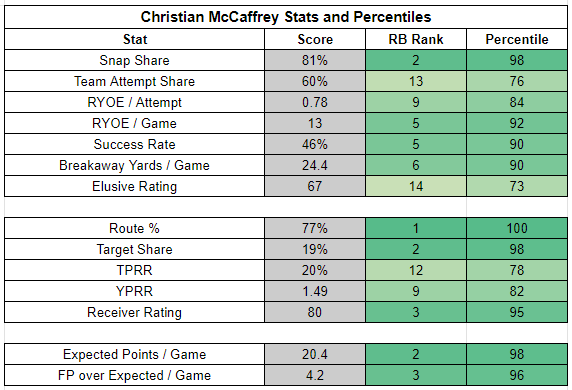
Seahawks Implied Team Total: 18
Geno Smith is dealing with an elbow injury, but he looks likely to play through it. As fans of football, we’d strongly prefer to see that. Smith hasn’t been great this season, but he’s far more consistent than Drew Lock.
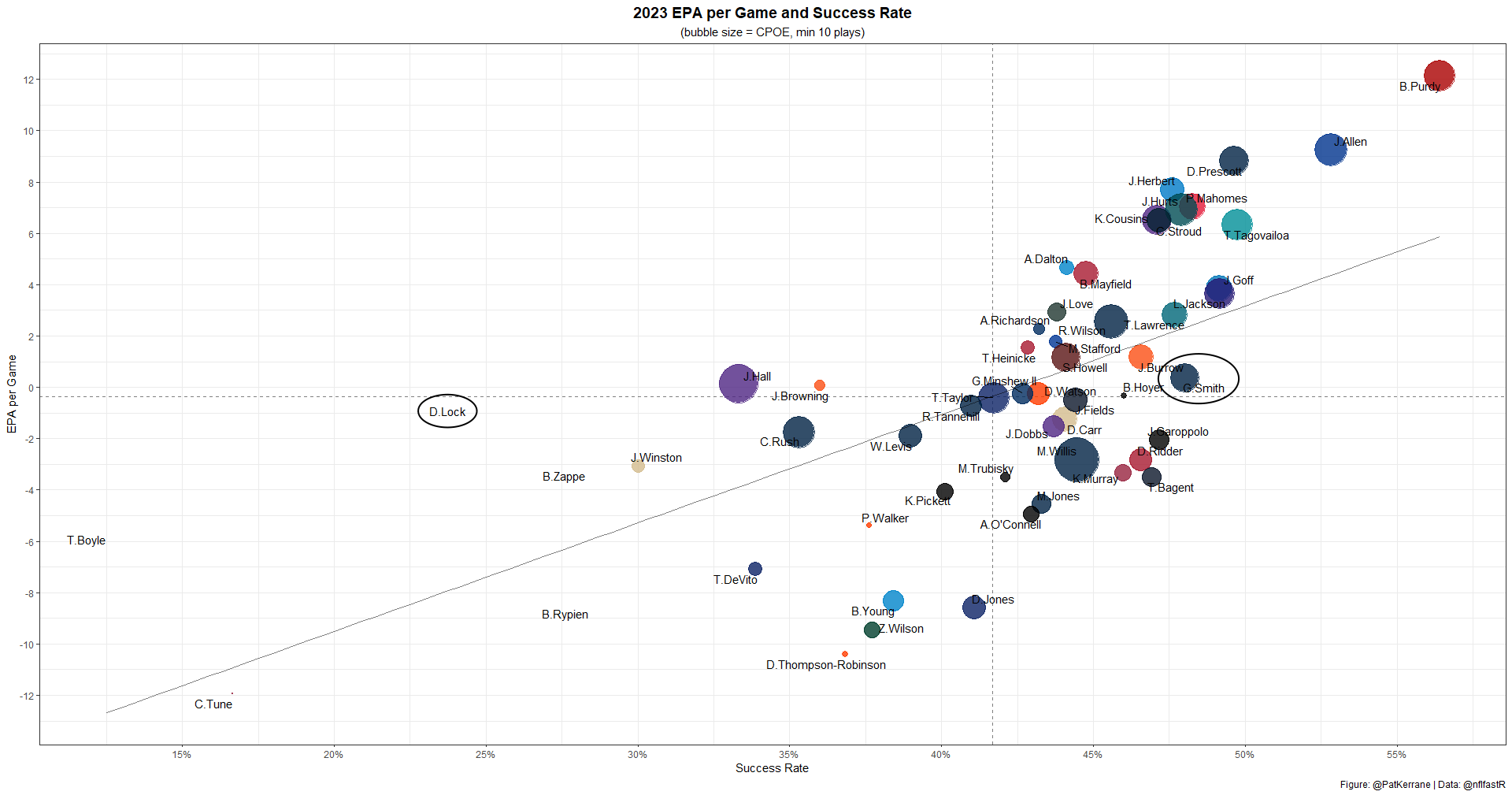
The issue for Smith is that he’s also facing a 49ers defense that has been very strong againt the pass this season. They pressure the passer without blitzing and are very strong in coverage.
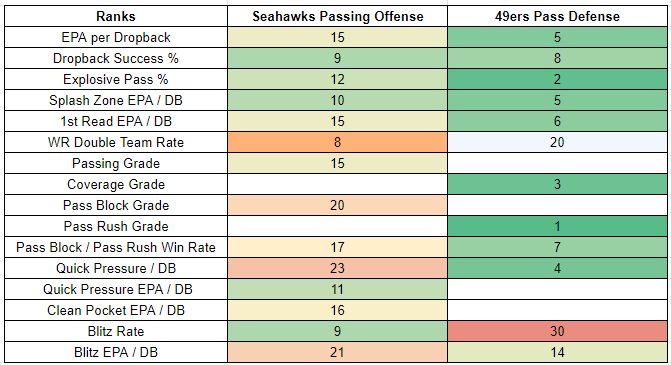
The 49ers are all the more difficult because you can’t afford to play conservatively against them. The offense puts up too many points.
49ers opponents are averaging a 71% pass rate this year. If we counted the 49ers combined opponents as a team, they would be tied with the Bengals for second in pass rate, behind only the Commanders (74%).

And assuming Smith is up to it, we shouldn’t expect Pete Carroll to shy away from this matchup. The Seahawks have a 2% PROE and a 6% PROE on 1st-and-10. They are a pass-first team. And Seattle has played in enough positive game script to justify a tilt to the run.
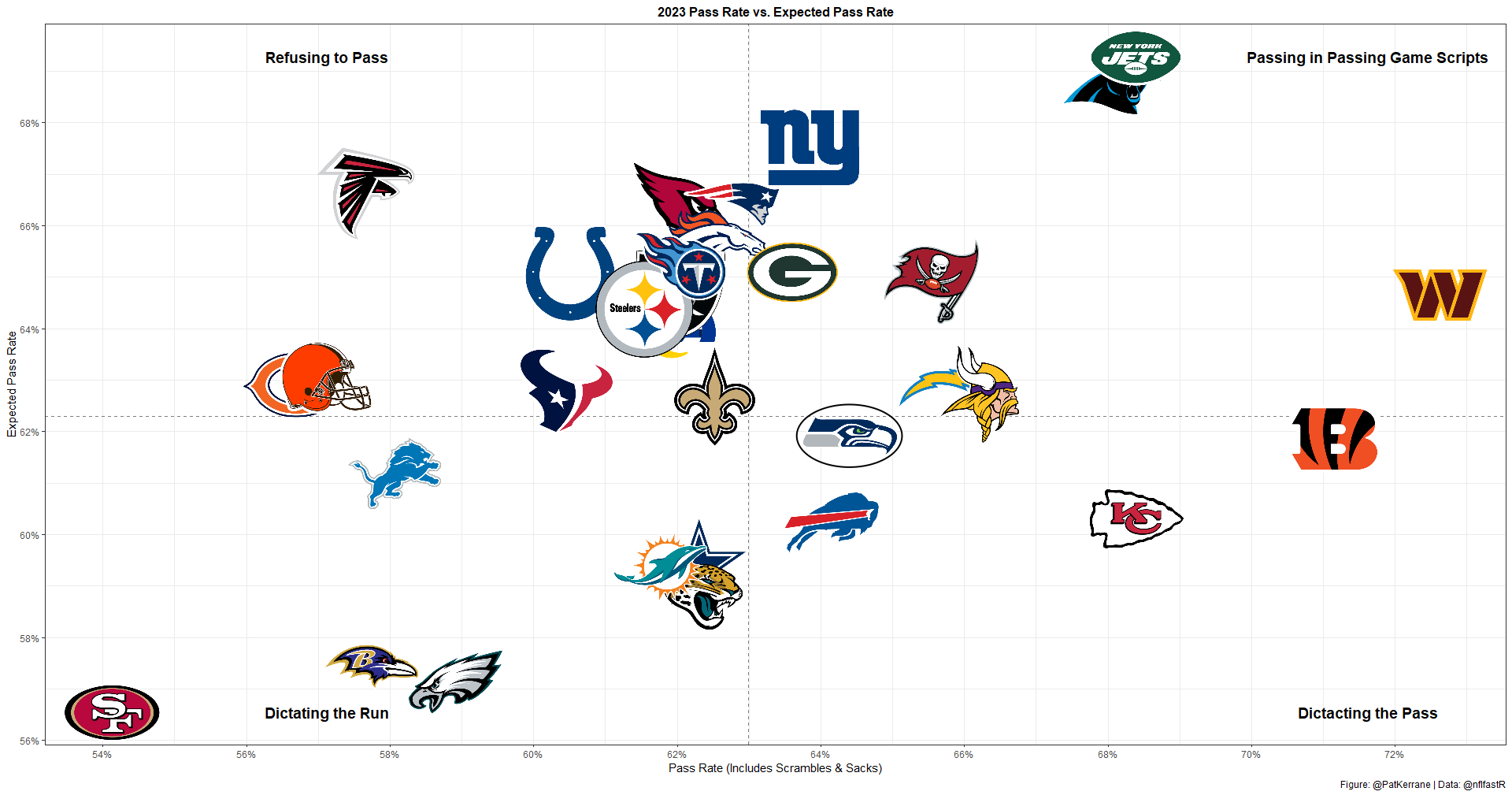
Smith has largely been pretty good this season. But when he’s not playing well, he sometimes plays very poorly. His efficiency cratered against both the Giants and Ravens. At less than full health, this is a dangerous matchup for him. Because while I’m usually a fan of passing volume, a less-than-fully-healthy QB being forced to throw against a strong pass defense doesn’t seem ideal.
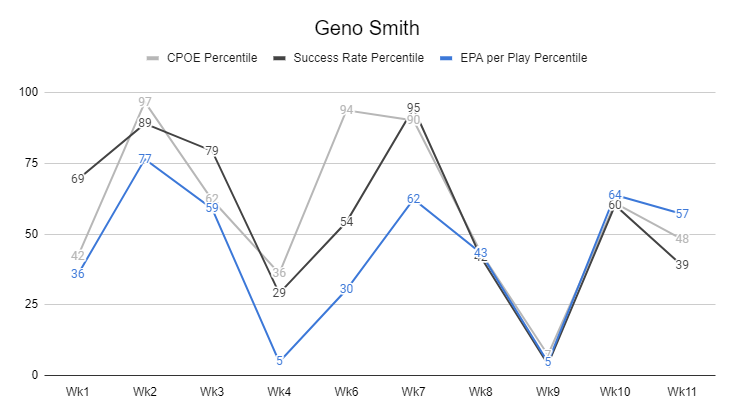
The Seahawks also appear unlikely to have Kenneth Walker, which will only increase their dependence on Smith to move the ball. Walker is dealing with an oblique strain and appears unlikely to play on Thursday night.
That will leave Zach Charbonnet to carry the load. Charbonnet has been consolidating routes for weeks, which sets him up for an elite workload with Walker out. We saw that materialize last week, with Charbonnet handling 85% of snaps, 71% of carries, and 17% of targets.
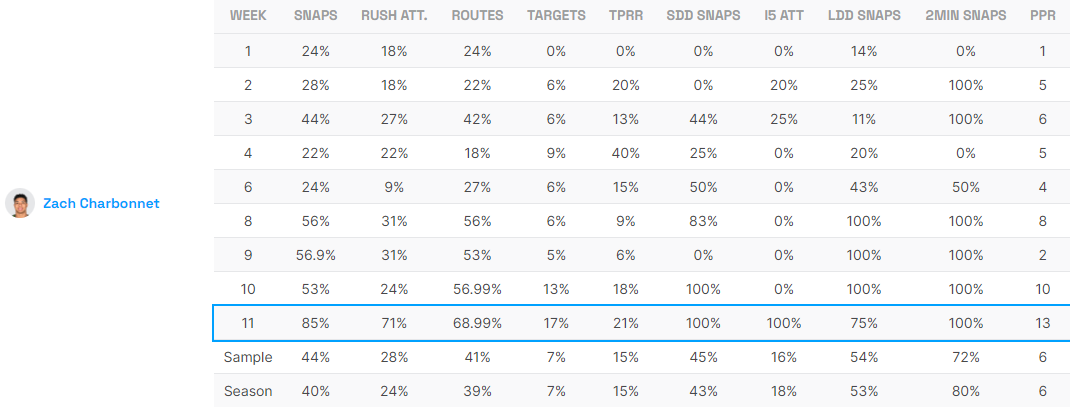
Per PFF, Charbonnet’s workload against the Rams was worth 17.8 PPR points. But he underperformed by 4.9 points. But Charbonnet could be more efficient this week against a middling 49ers run defense that has allowed some big plays.

Crucially, given the context of this matchup, Charbonnet looks far less game script dependent than Walker. He’s a lock to run 50%+ route participation and is a good bet for a double-digit target share. Charbonnet profiles as a high-end RB2, even with game script likely to go against Seattle.
This could be a rough game for the Seahawks offense. But there’s also potential for increased passing volume. And as long as Smith can be sufficiently efficient, that volume creates upside for his WRs.
DK Metcalf has separated from the pack in terms of efficiency this year. He has an elite 2.11 YPRR, with Tyler Lockett at 1.67 and Jaxon Smith-Njigba at 1.33. But Lockett and JSN are running cold on per-target efficiency. Metcalf is still seeing the most valuable target volume, but the gap – to Lockett in particular – is closer than his production suggests.
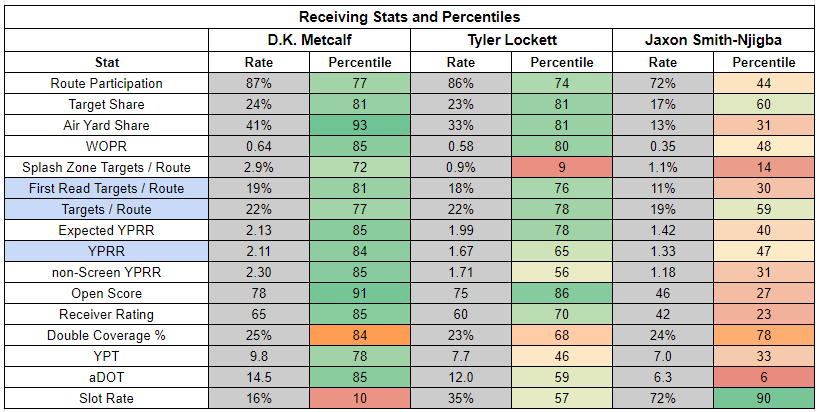
Metcalf and Lockett remain the clear top options in the passing game, but this is an interesting setup for Smith-Njigba. With a 6.3 aDOT, JSN is the most dependent on passing volume. And for all it’s other issues, this matchup should produce dropbacks.
This matchup should also force Smith to get the ball out quickly. He won’t have a ton of time to pass against an elite 49ers pass rush. That suits JSN’s typical route tree, but it also sets him up for screen usage. Smith-Njigba has seen 21% of his targets on screens this year. By comparison, Lockett is at just 6%, and Metcalf is at 2%. Admittedly, even if this angle hits, we’re probably talking about 1-2 additional targets. But Smith-Njigba is averaging 2.2 PPR points per screen target… which is not nothing.
Dolphins at Jets, 3 PM, Black Friday
Dolphins Implied Team Total: 25.5
Tua Tagovailoa has cooled off significantly since his hot start to the season, finishing 50th percentile or lower in EPA per play in five of his last seven games.
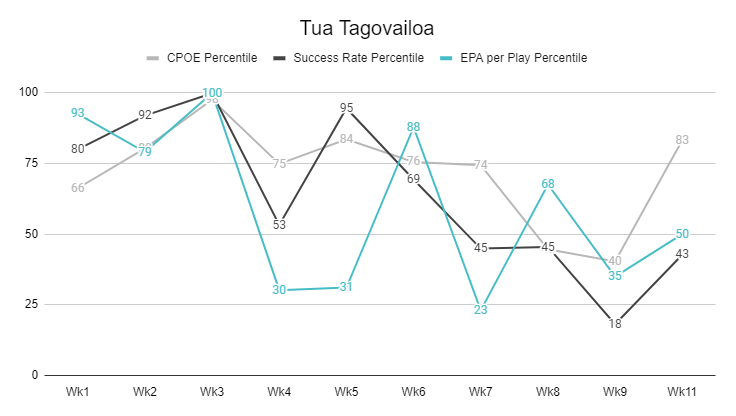
But even with his efficiency dipping, Tua has managed three 300+ yard passing days, including last week against the Raiders.
The issue this week is that he gets a tough matchup, and the Dolphins don’t really need to test the Jets through the air. After all, most teams don’t.

The Jets run defense is actually pretty solid, ranking top 10 in all the rushing metrics I typically reference.

The Jets aren’t bad on the ground… but their offense is grounded. The Jets have scored 13 or fewer points in 6-of-10 games this season. Since their Week 7 bye, the Jets are averaging 9.25 points per game. Two TDs will literally put this game out of reach… that allows for some pretty conservative play calling. If you don’t want to pass against the Jets’ elite pass defense, you don’t have to.
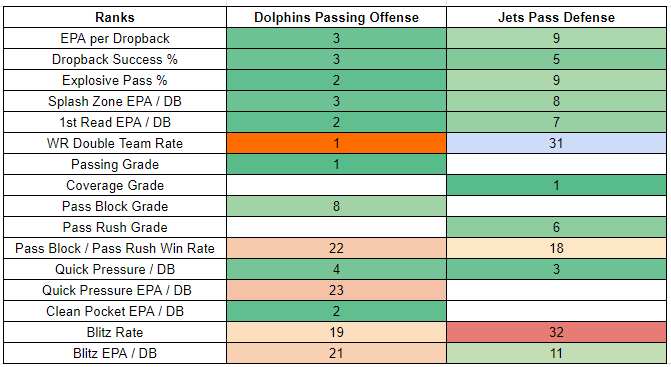
But even though Tagovailoa has cooled off, his efficiency still looks impressive from a season long persepctive. Tua ranks QB9 in EPA per game and QB3 in success rate.
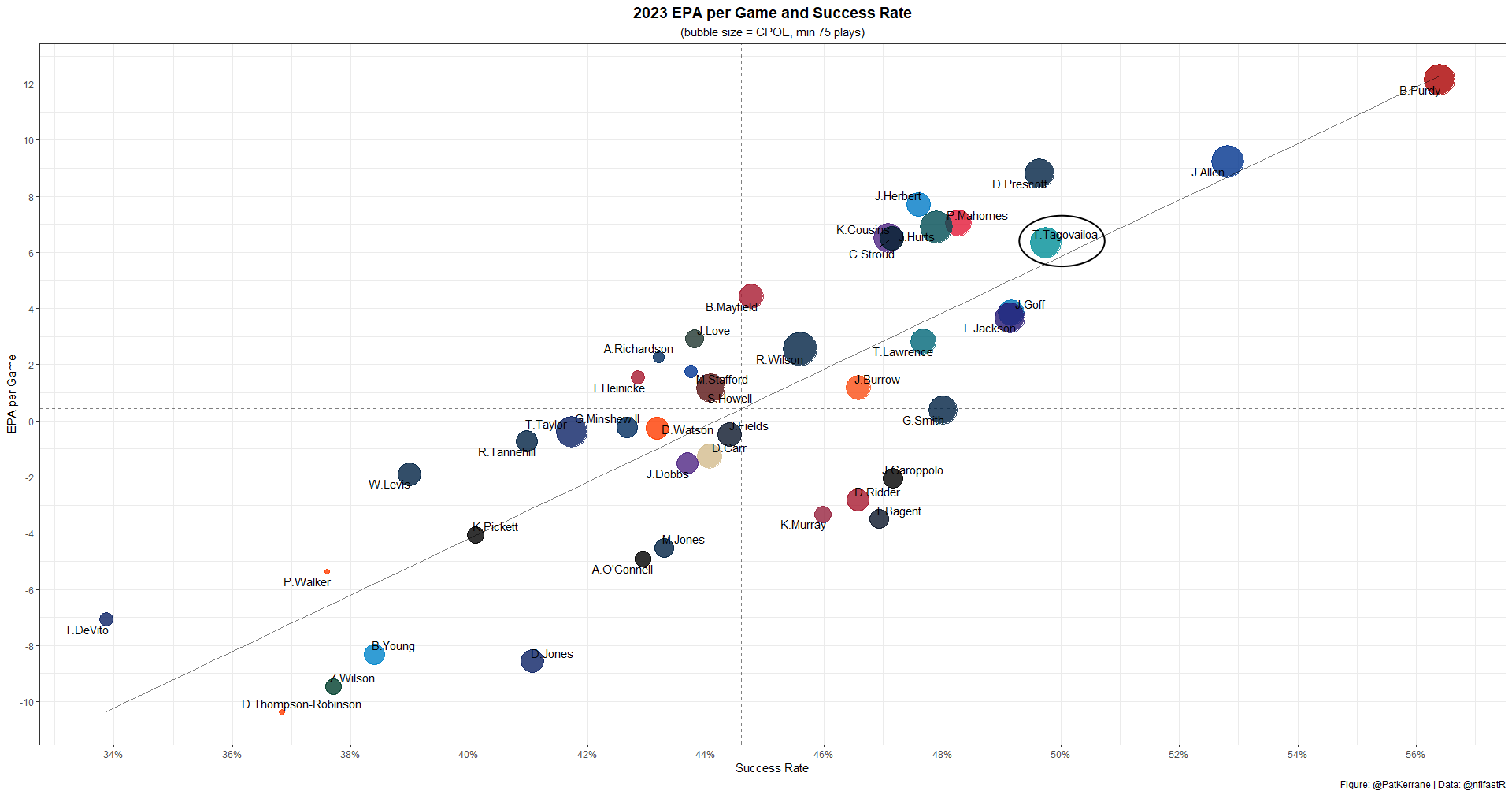
And we can be extremely confident that the passing game will flow through Tyreek Hill. Hill leads the NFL with a 4.06 YPRR. That number is impossible produce sustainably… but Hill is about as close as we ever see. His 35% TPRR also leads the NFL.
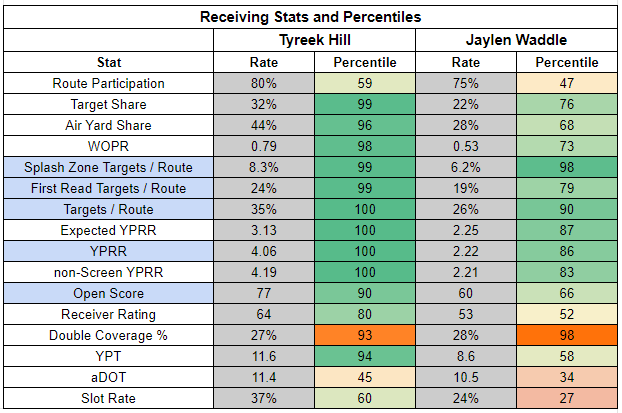
I know Hill gets a tough matchup here… but the Jets could be in trouble if they are buying their own hype. As good as they are, they’re not going to stop Hill in one-on-one coverage. And the Jets rarely double team WRs. This matchup isn’t good. For one thing, passing volume could be a major problem. But this is an intriguing setup for Hill against a defense that could be confident enough to do something no other defense would dare to—allow Hill to test them in single coverage.
Jaylen Waddle’s setup is worse all around, but Waddle also tends to deal with a ton of double coverage. If the Dolphins can withstand the Jets’ impressive pass rush, Hill and Waddle should be capable of getting it done, even against this vaunted coverage unit.
In the backfield, the Dolphins appear to have dodged a bullet, with De’Von Achane day-to-day with a knee injury. It’s possible we see him Friday. In the words of Mike McDaniel, “I definitely would not rule him out, but would definitely not rule him in, either.”
If Achane plays, he’s likely to be limited. But if he looks on track for something close to his usual workload, it’ll be hard not to bet on him as an RB2.
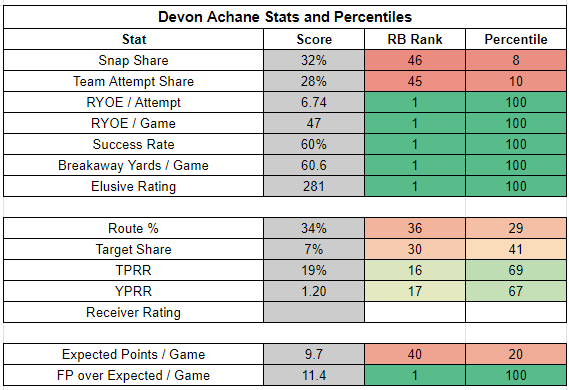
Raheem Mostert will likely handle a slight majority of carries, regardless of Achane’s status. Even after a quiet game against the Raiders, his efficiency remains impressive. He’s a solid RB2.
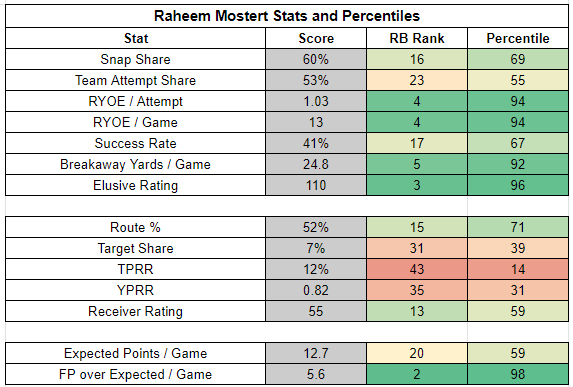
Jets Implied Team Total: 15.5
Look, I’ve been pining for the day I could write about a Jets QB who isn't Zach Wilson. But I have to be honest, I don’t see Tim Boyle making things better. He certainly didn’t last week.
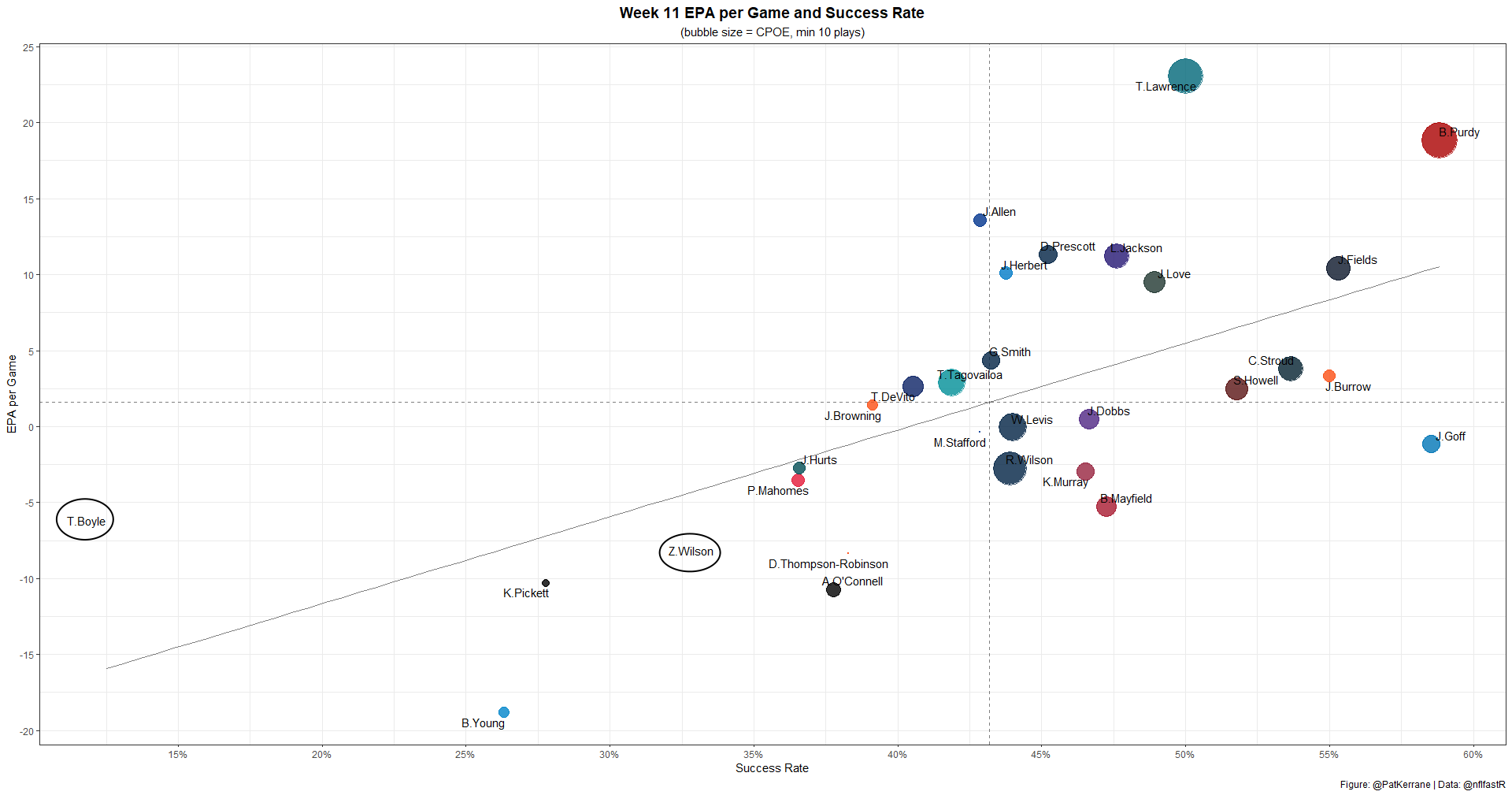
Since entering the NFL, Tim Boyle ranks dead last in success rate… at QB91. Sure, he’s been better in EPA per game than Zach Wilson, but who hasn’t?
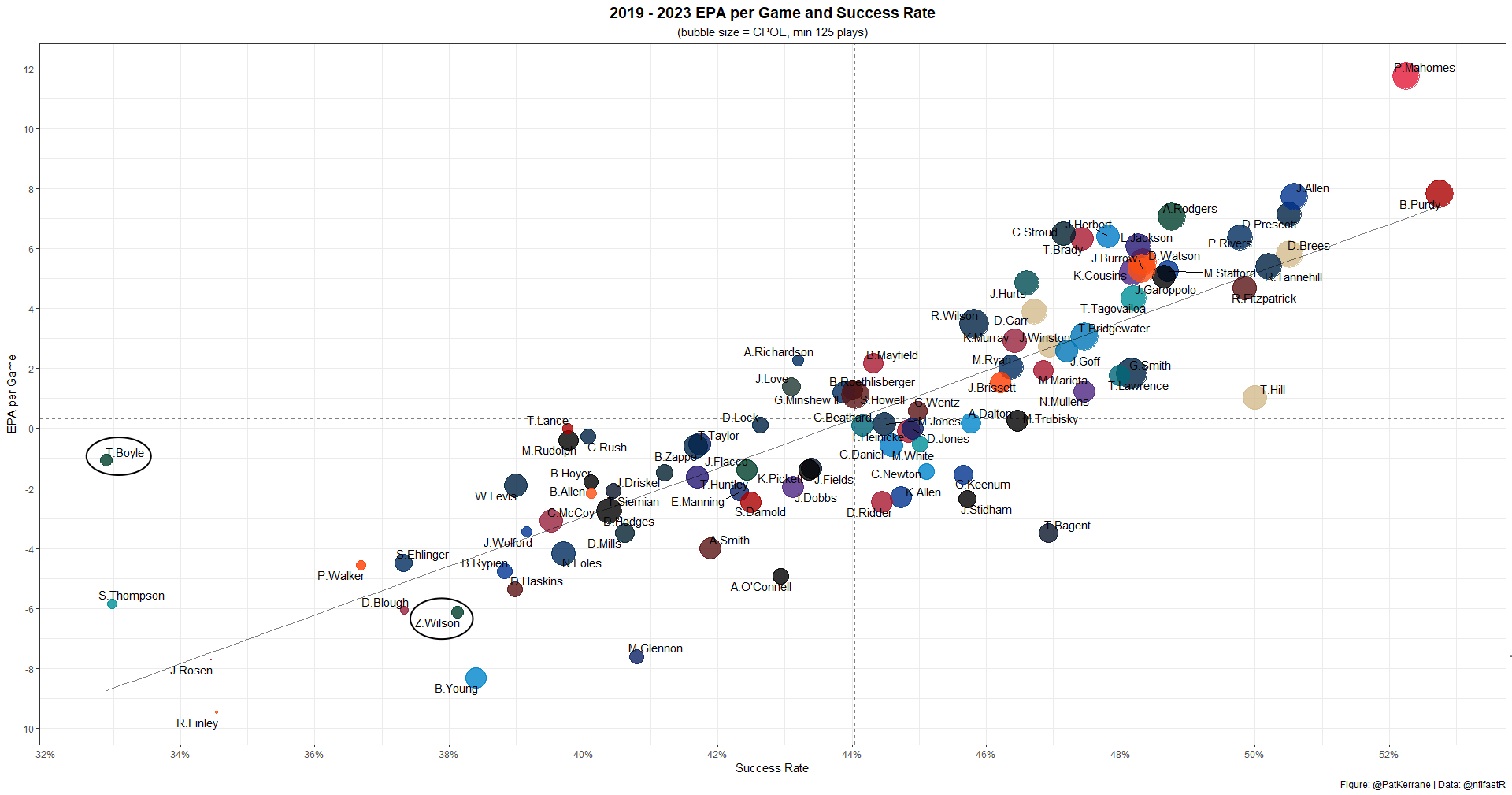
But honestly, I’m still letting myself hope. Having Zach Wilson at QB is like a northeast February. It’s not fun. But that’s not really the problem. The problem is the ceaseless monotony of predictably gross outcomes.
The numbers imply that Boyle’s lows will be even lower, but maybe we’ll see the sun poke through the clouds a couple times too.
Then again, this is a scary forecast.
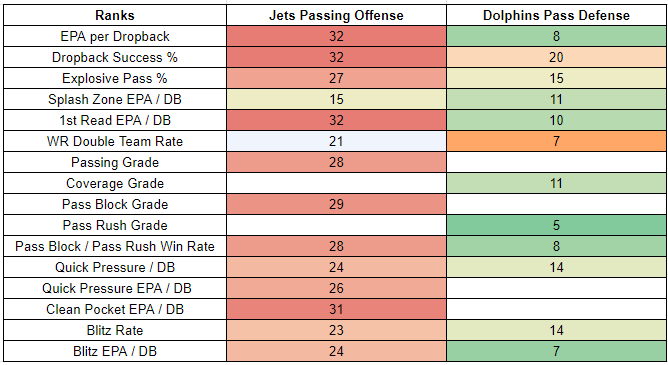
Vic Fangio’s defense is designed to limit big passing plays and has no issue double teaming opposing WRs. This is a rough setup for Garrett Wilson, who – despite immense talent – profiles as a FLEX.
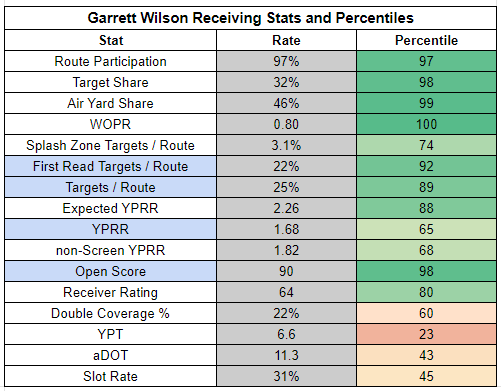
Fortunately, the Dolphins are more vulnerable on the ground, ranking 27th in EPA allowed per rush, 24th in rushing success rate, and 22nd in run stop win rate.

Breece Hall’s acceleration is incredible, and it’s showing up in all the big play efficiency metrics. Unfortuantely, he remains extremely inconsistent, and that will likely continue this week. But this is a good setup for Hall in his usual pray-for-a-big-play RB1 role.
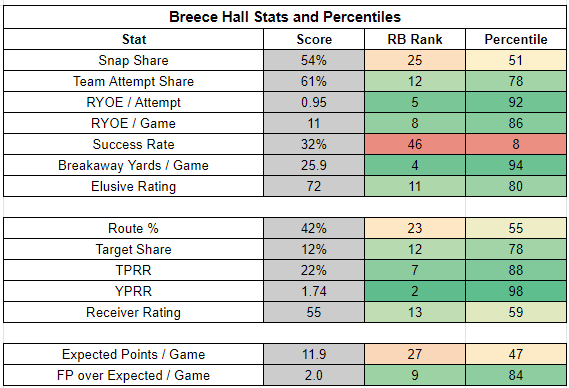
Edited by Nic Bodiford
PROE data for all 32 teams
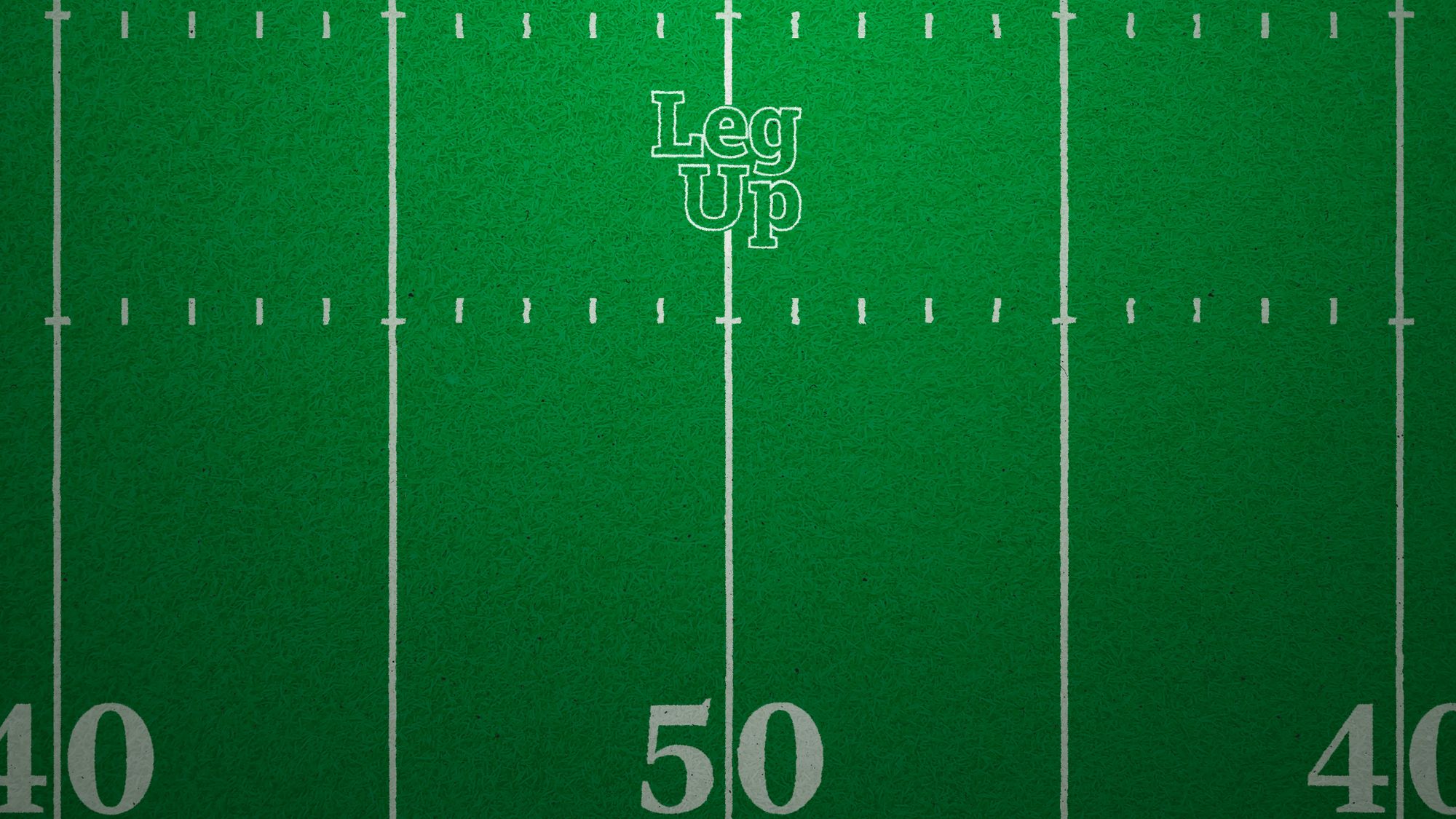
Full Newsletter Archive

Details on $50 Underdog Credit, 40% off Spike Week, Discord Access, Premium Podcast Feed



